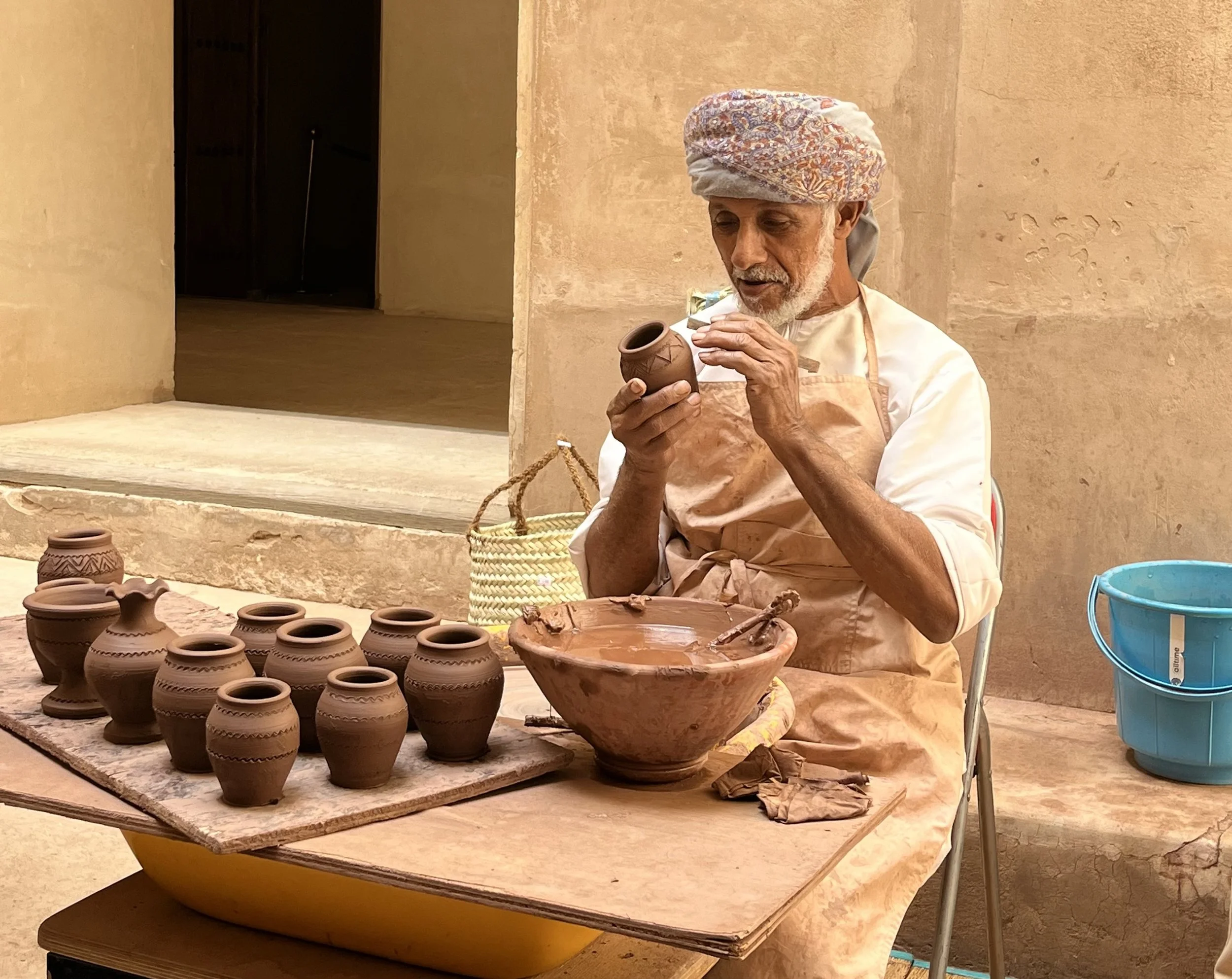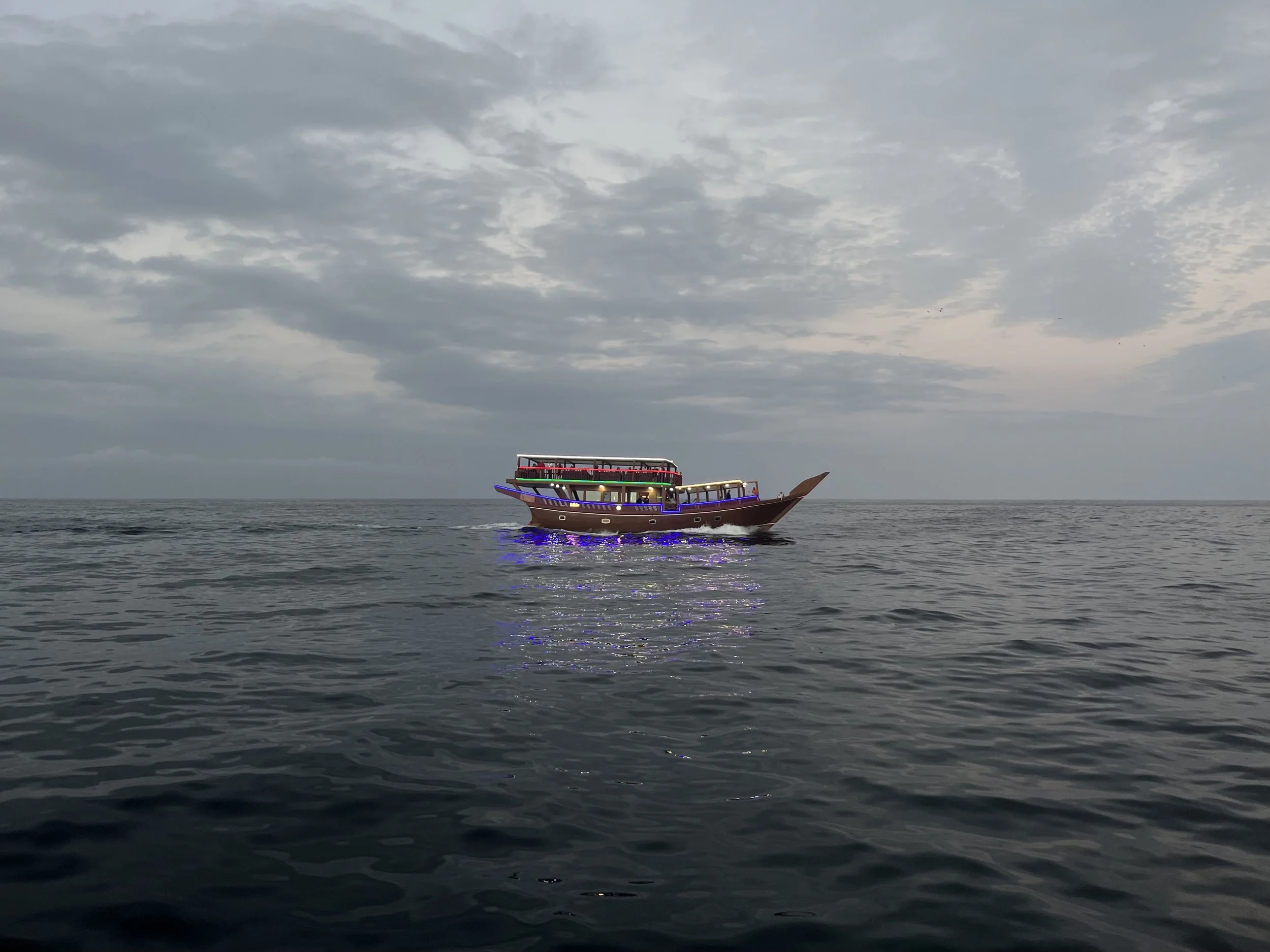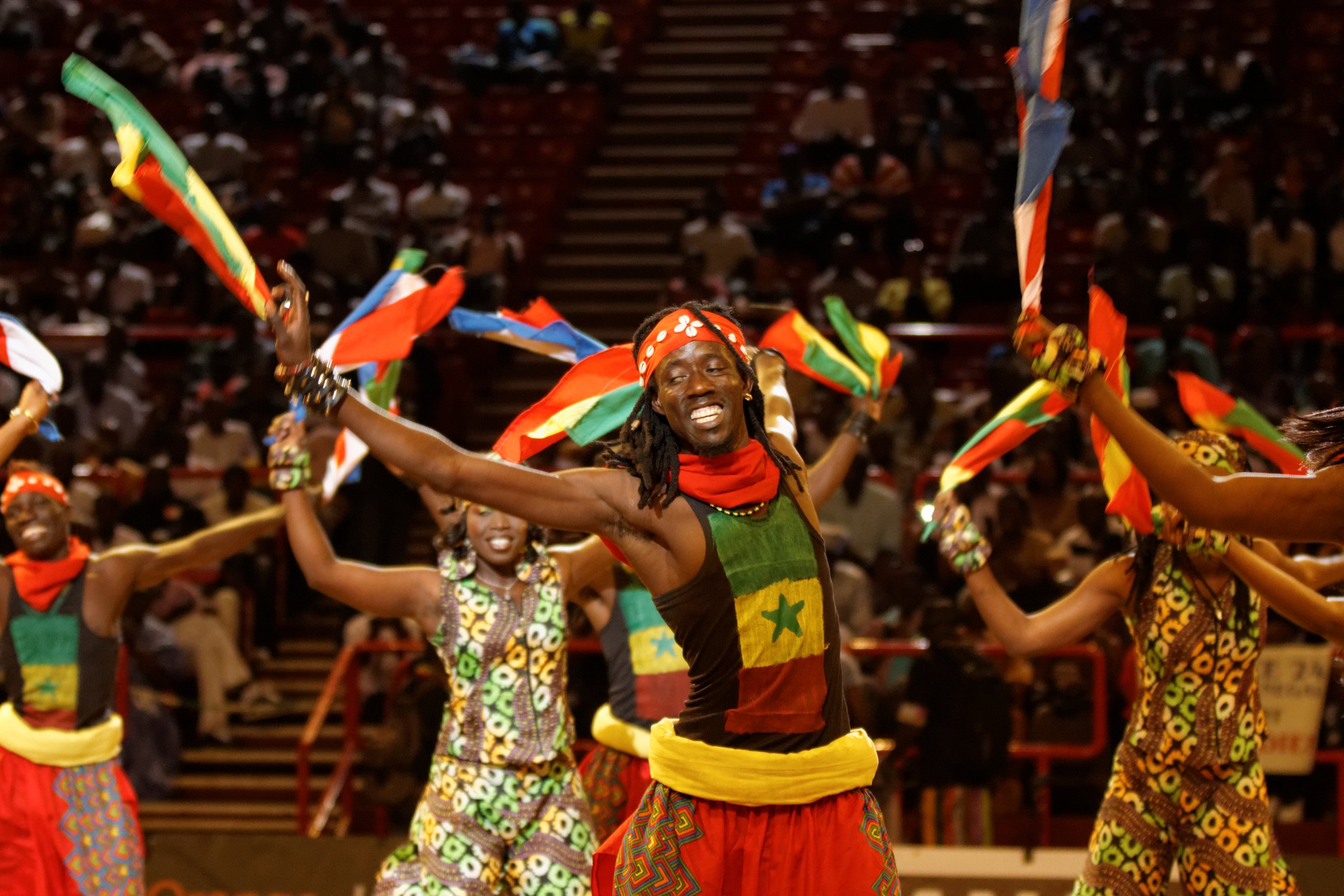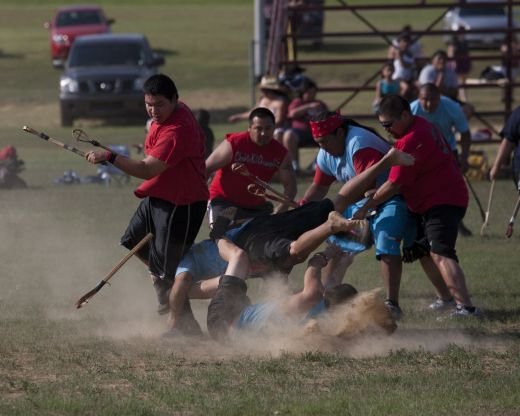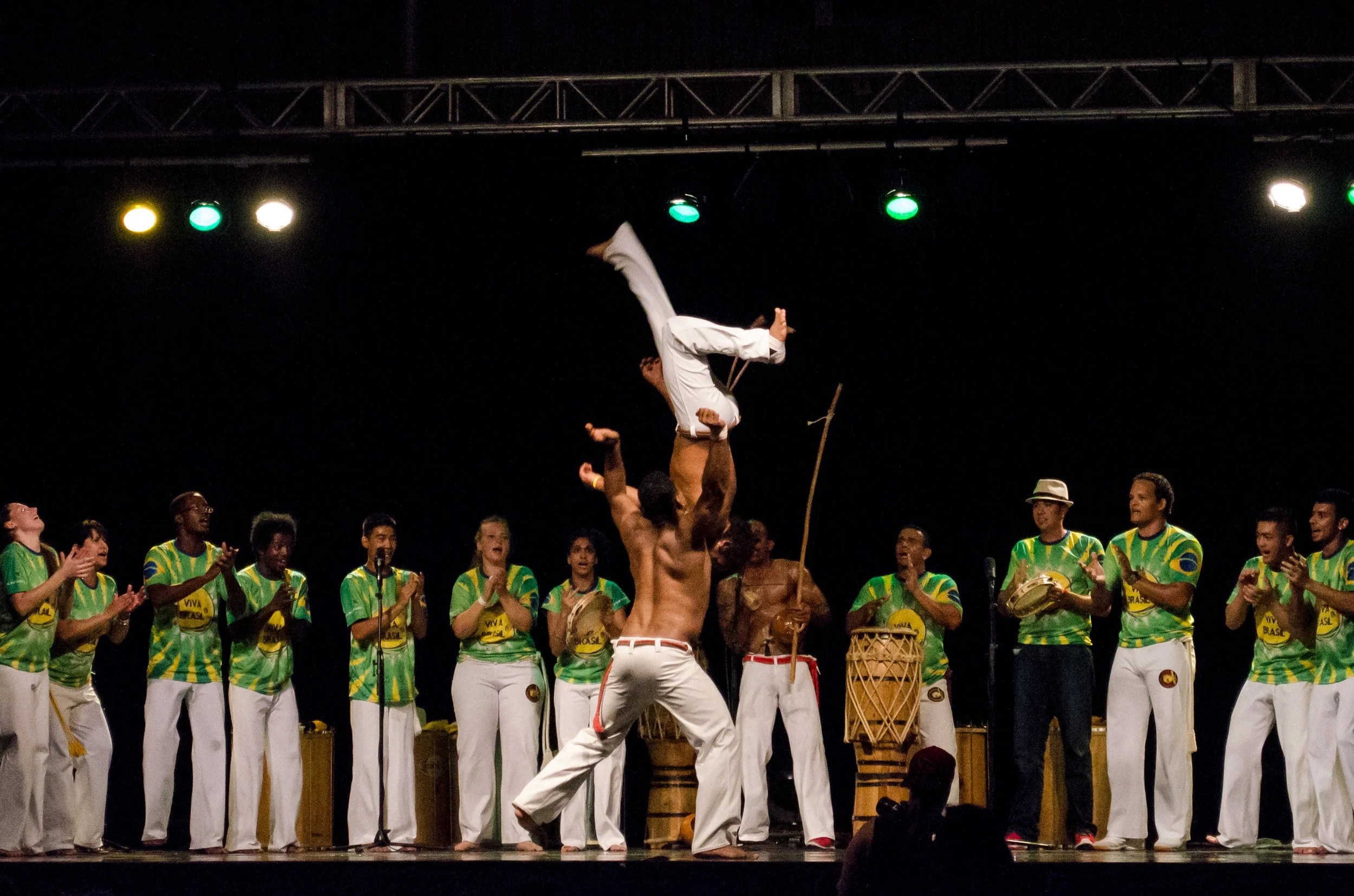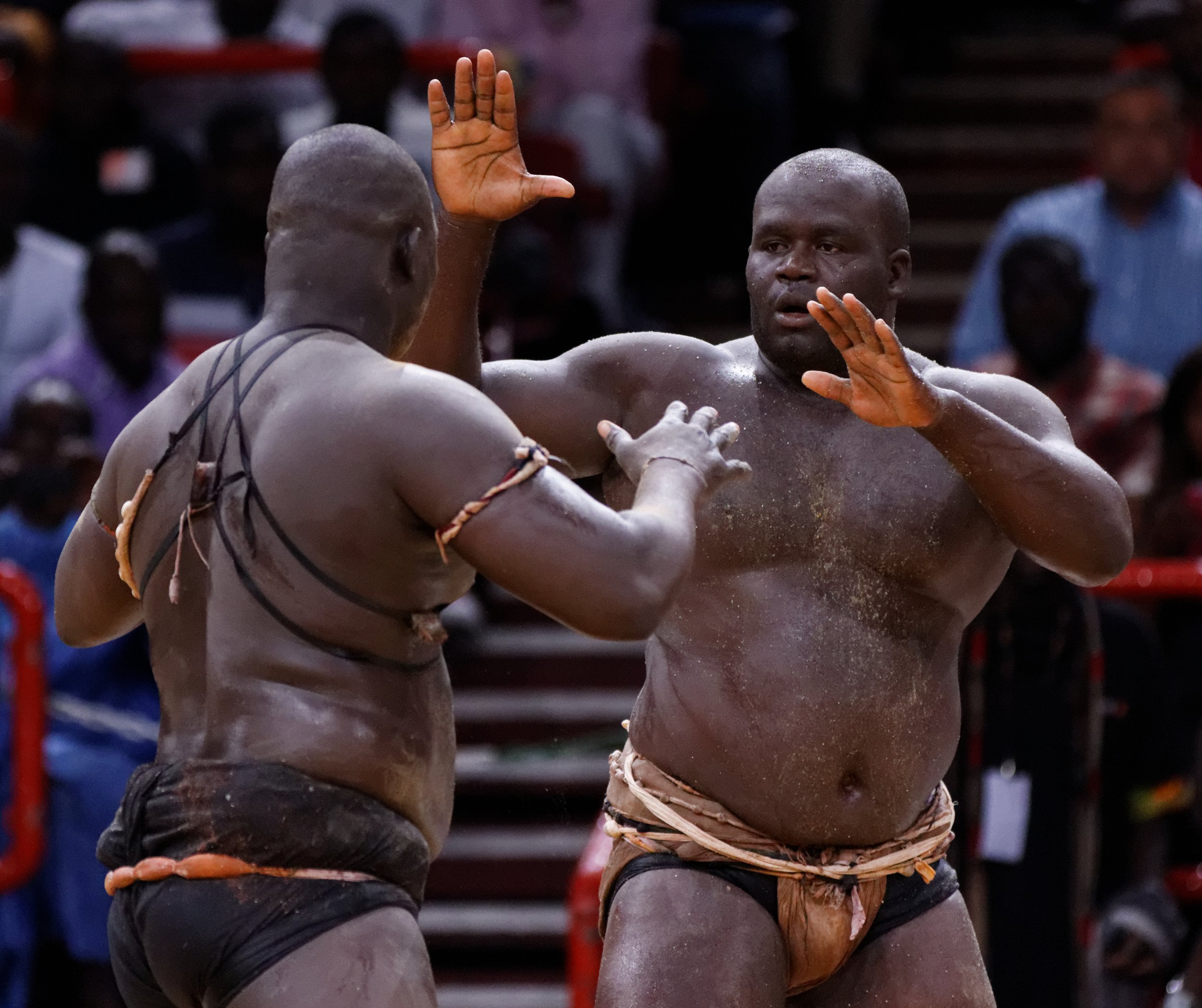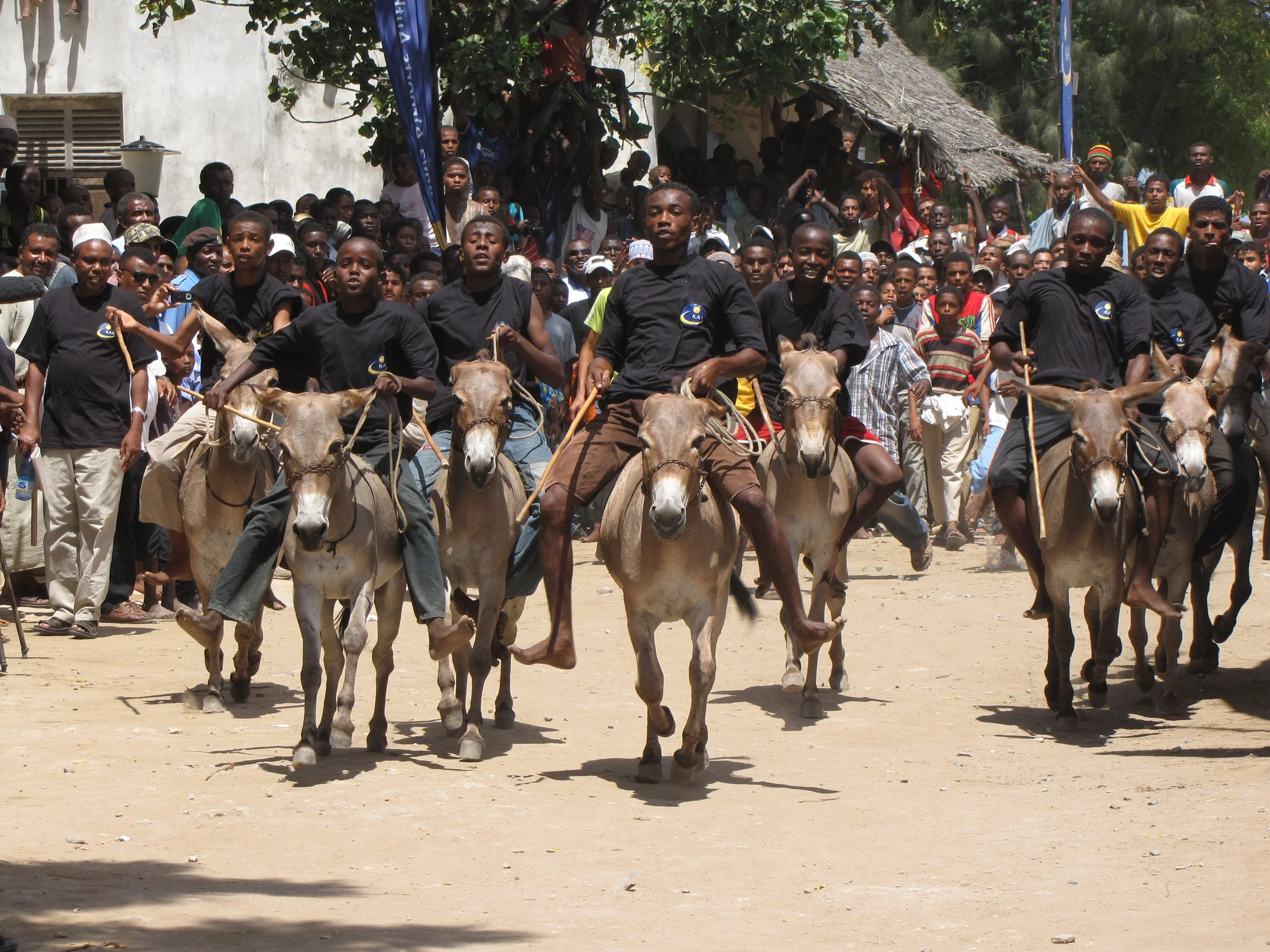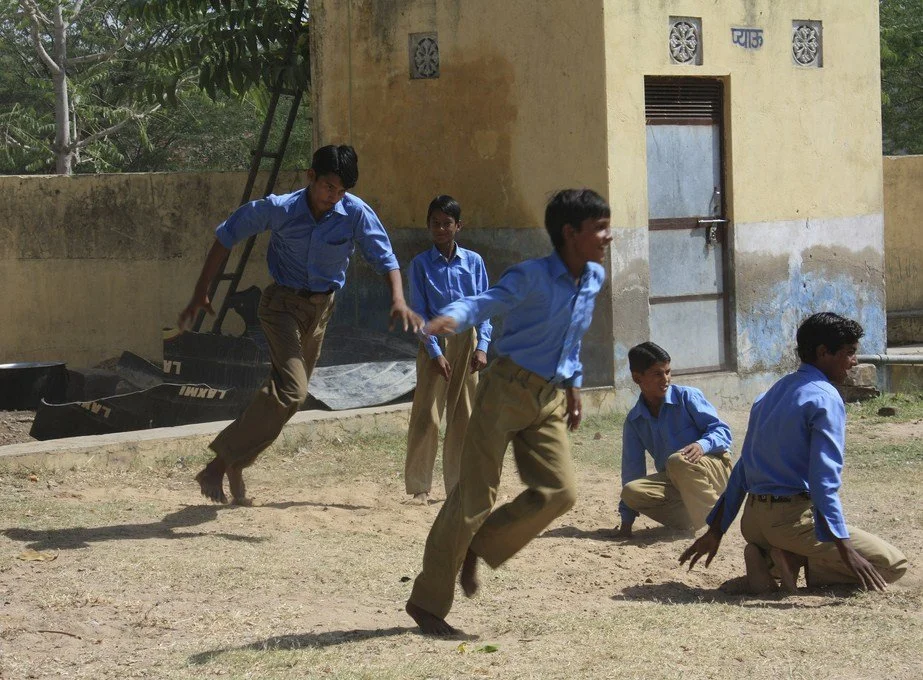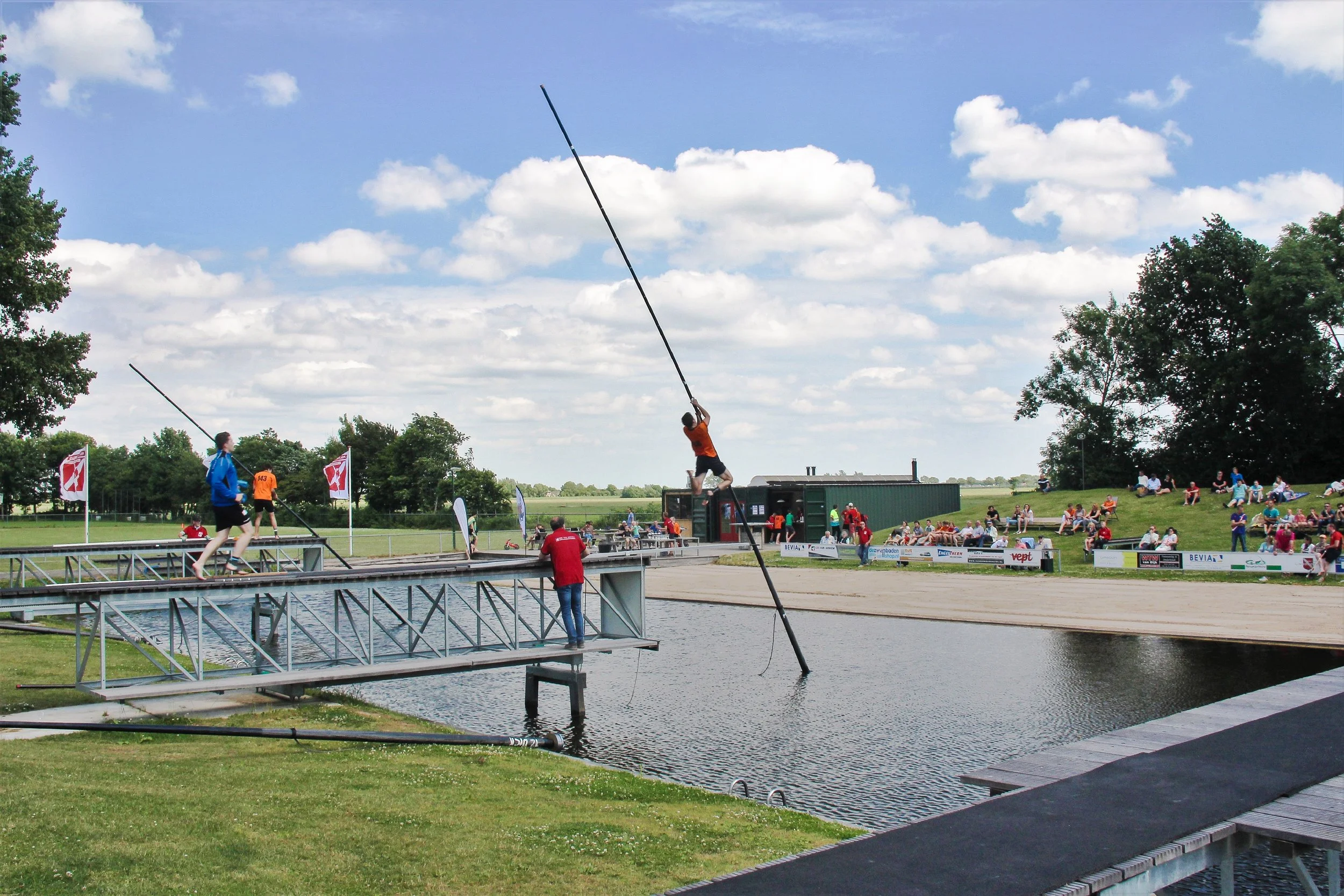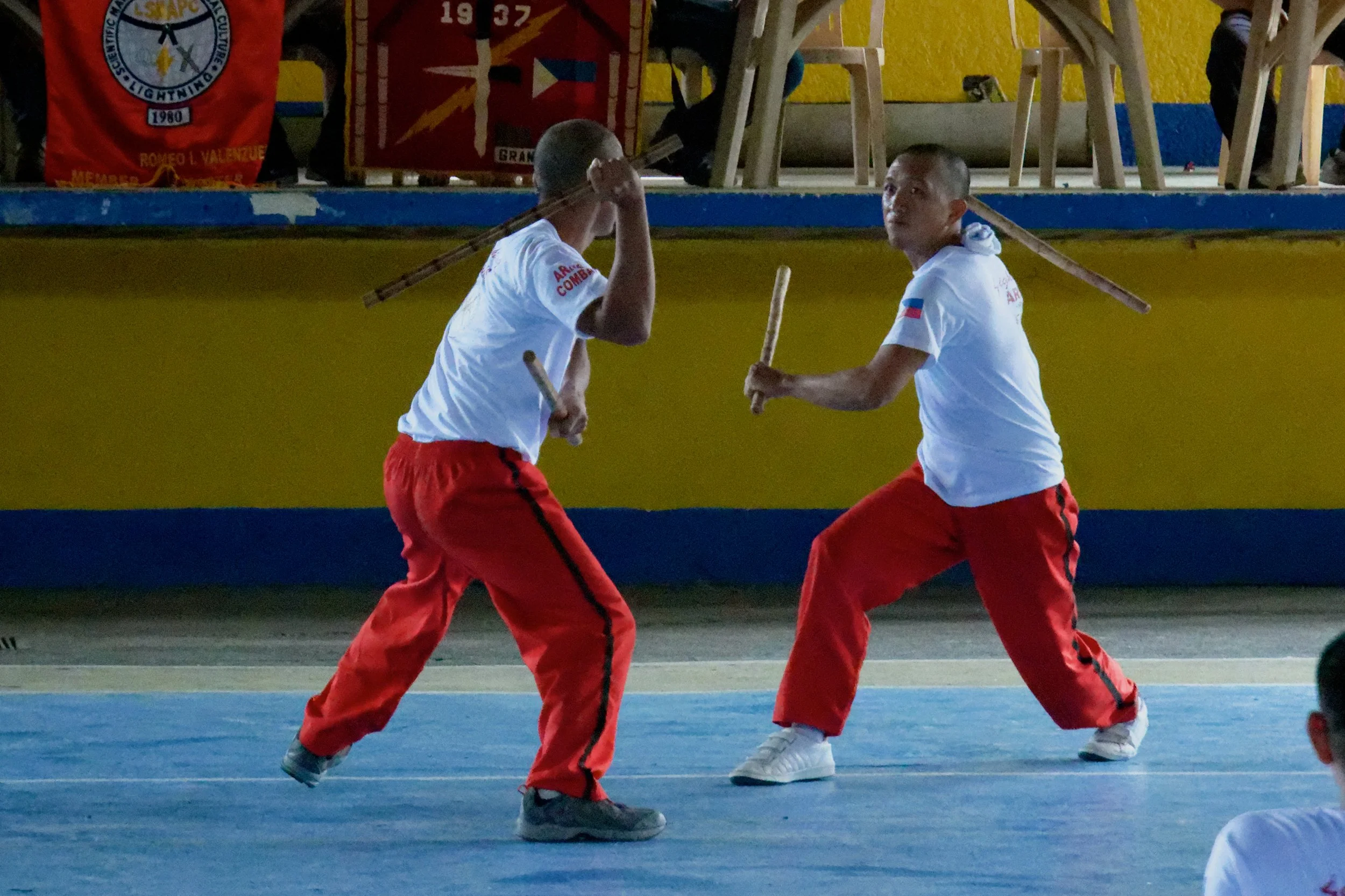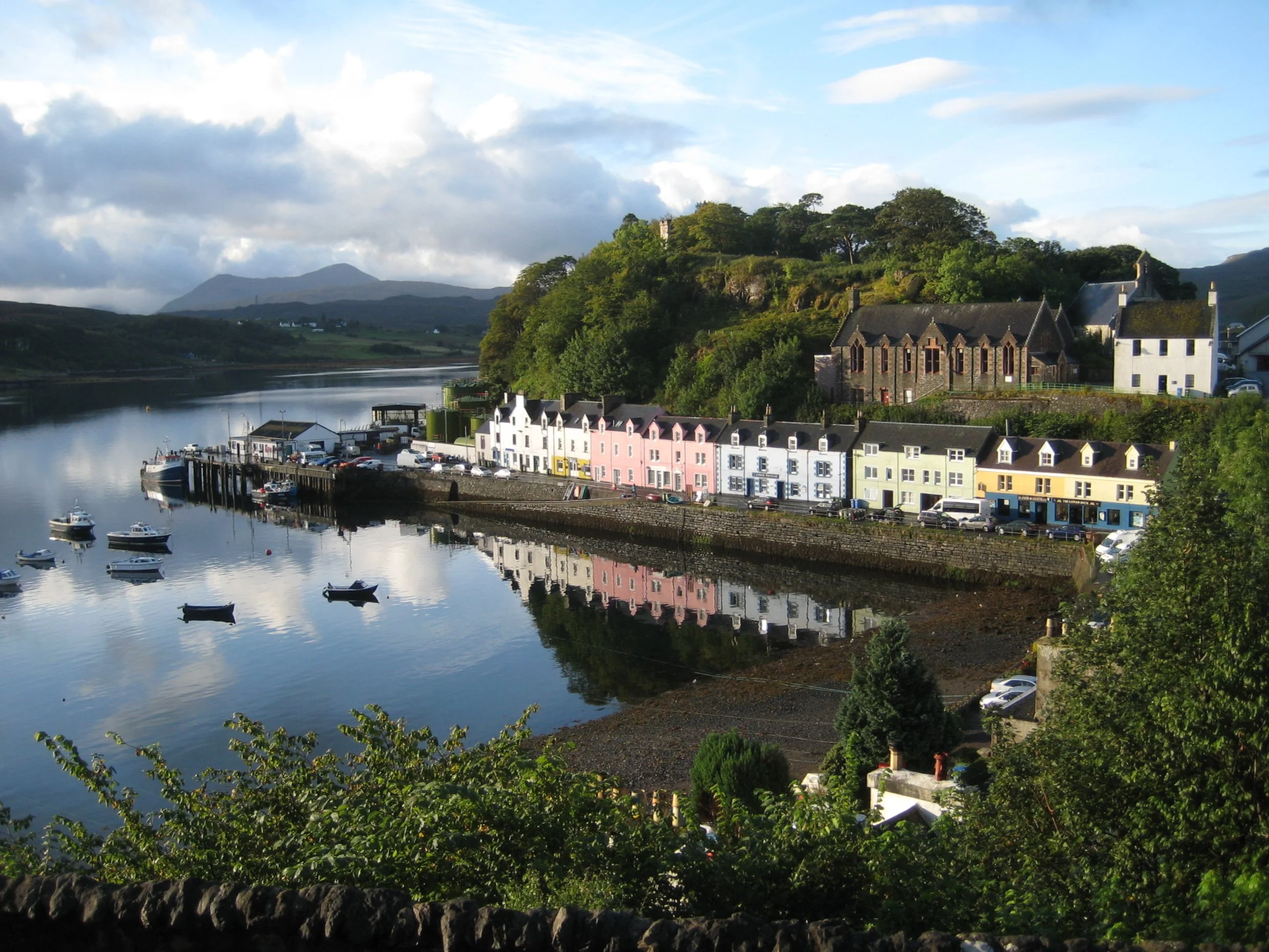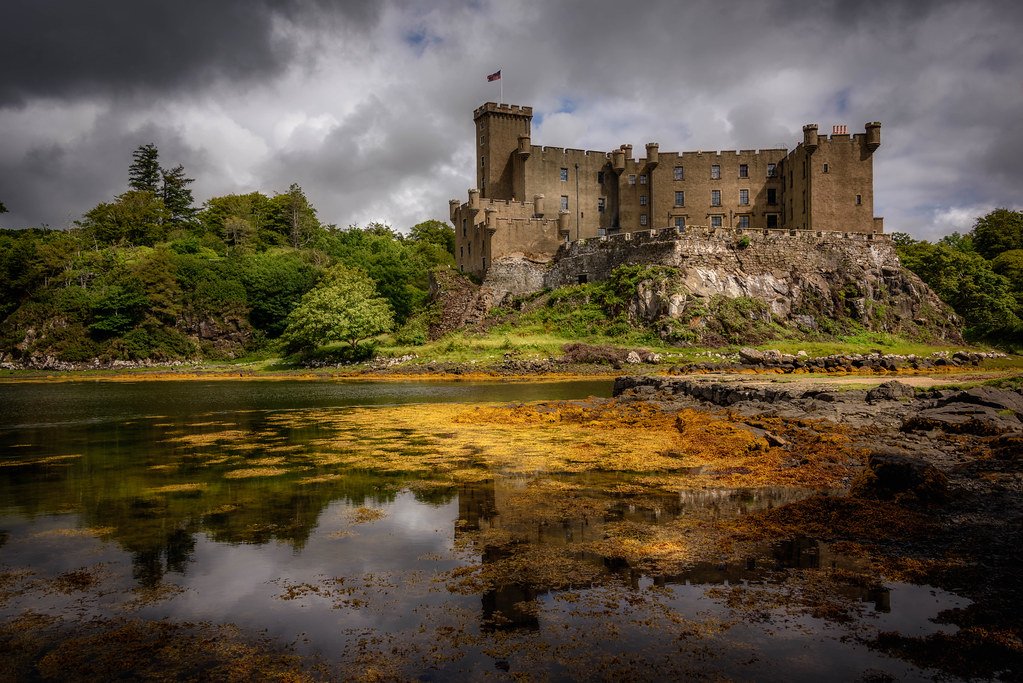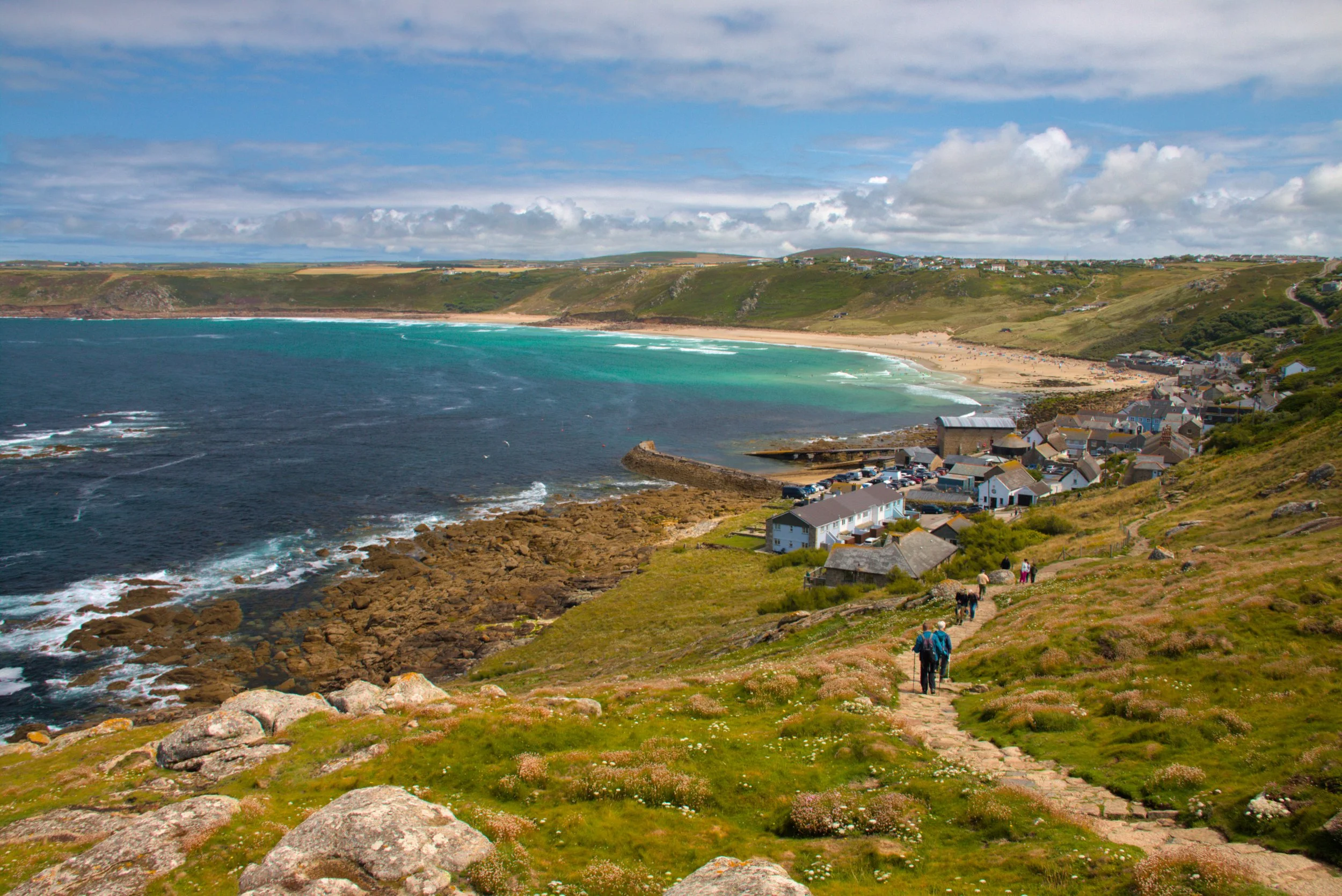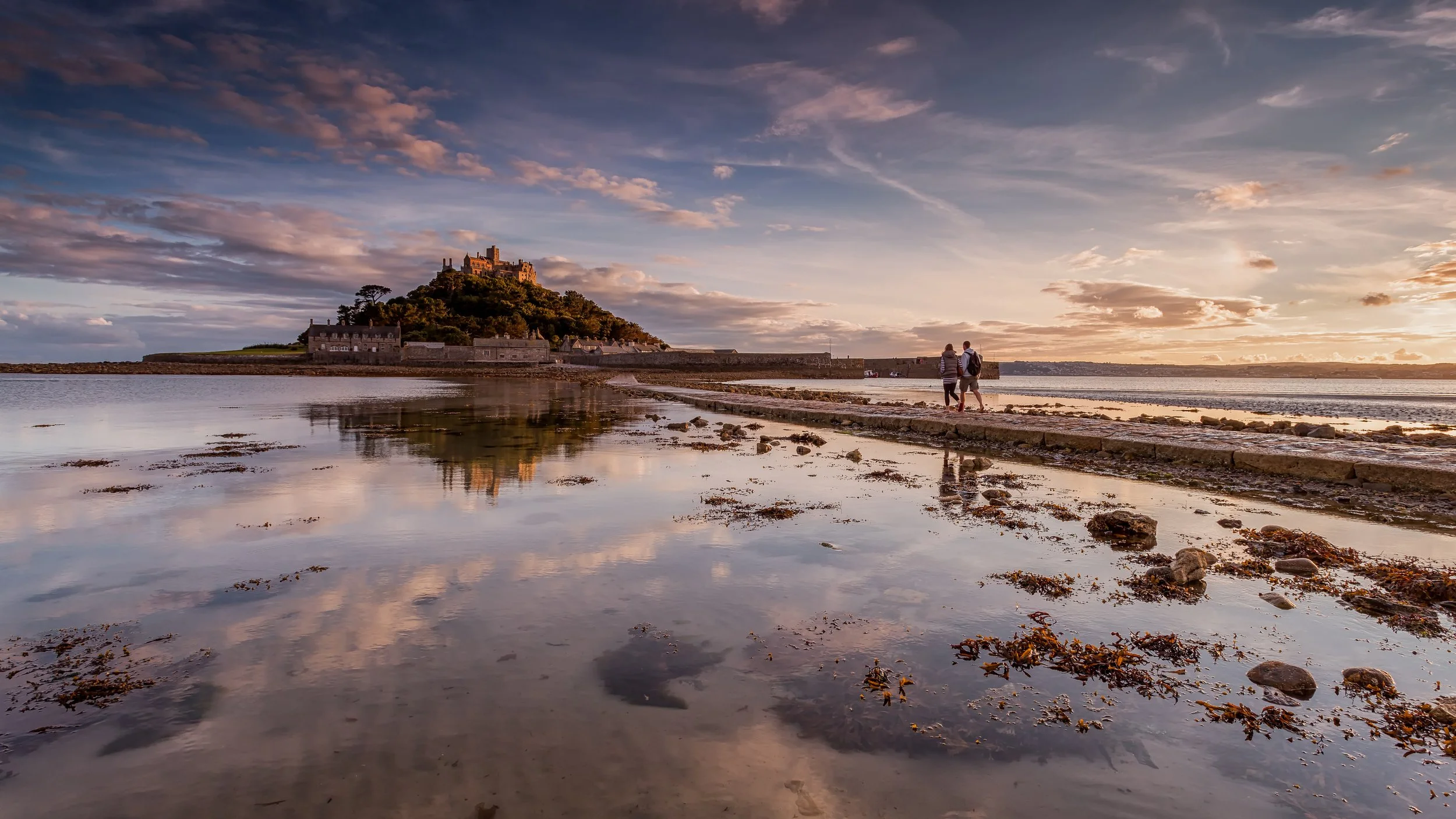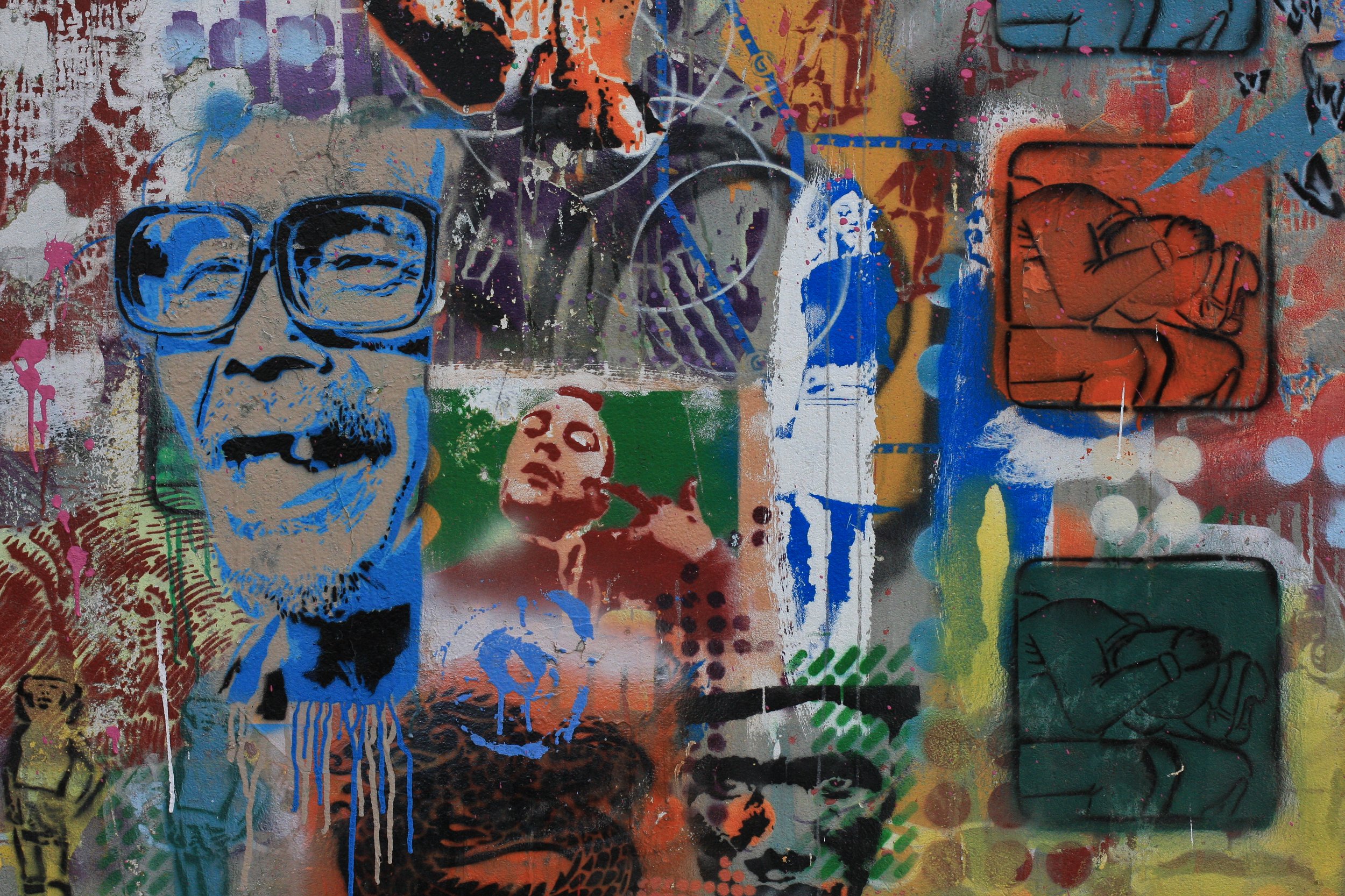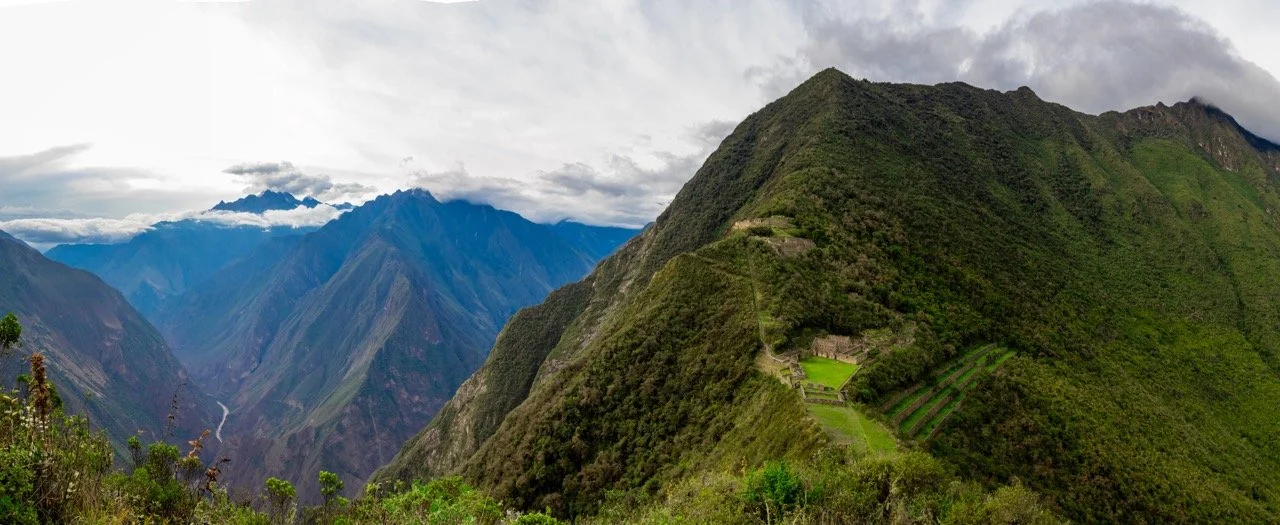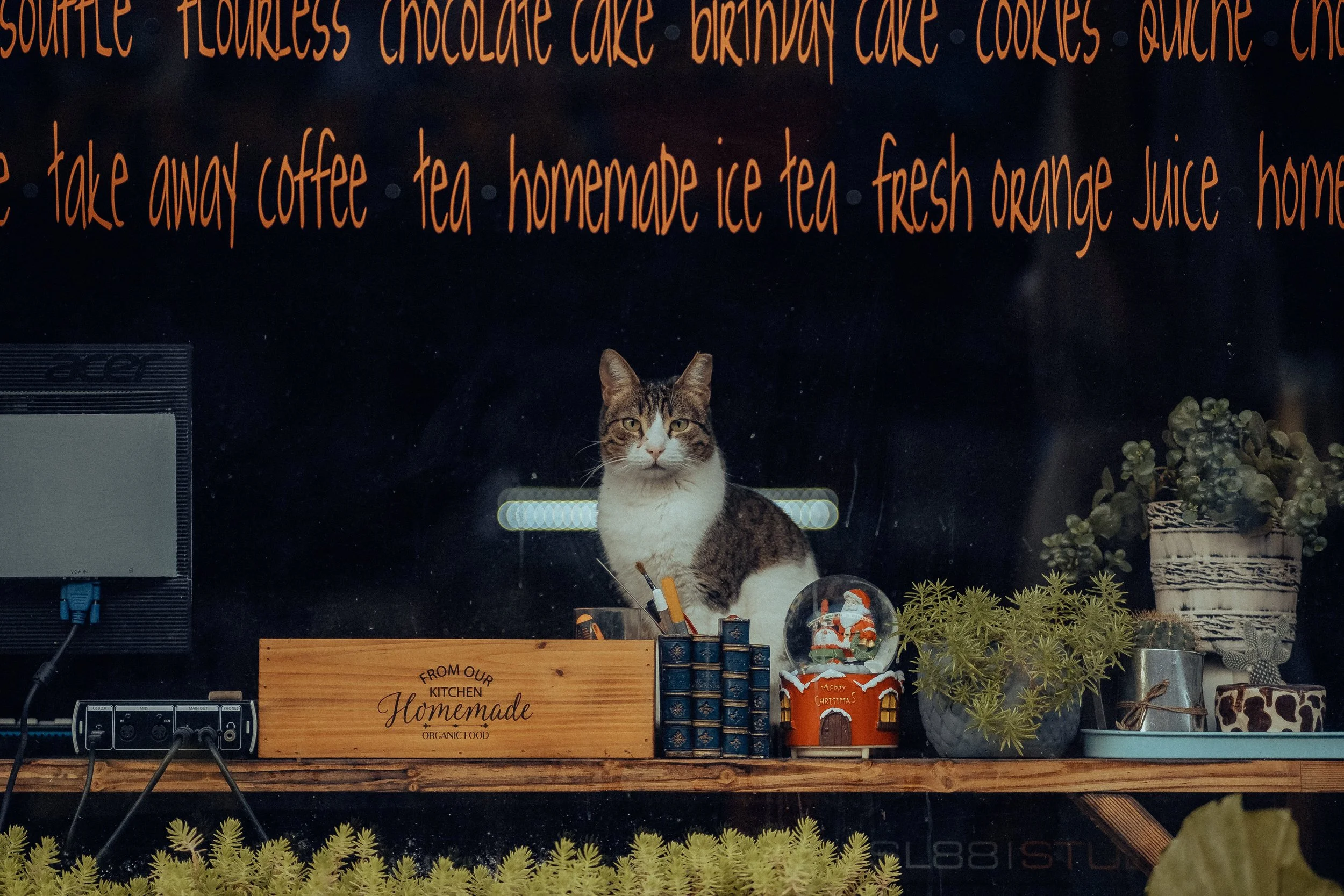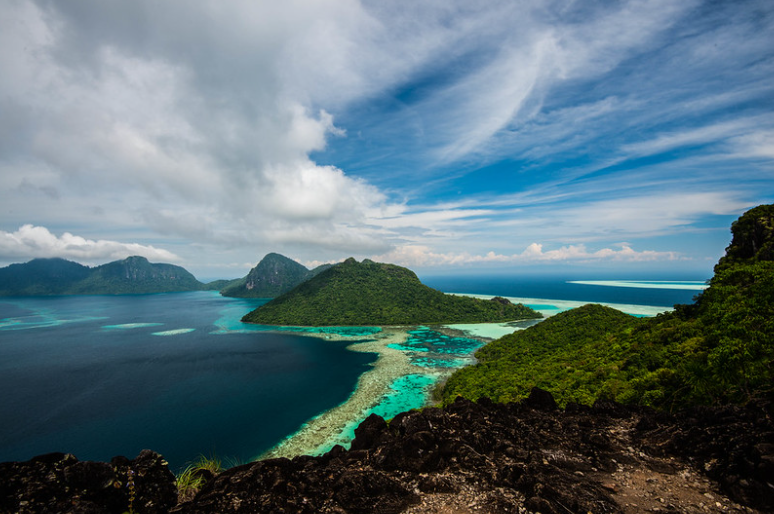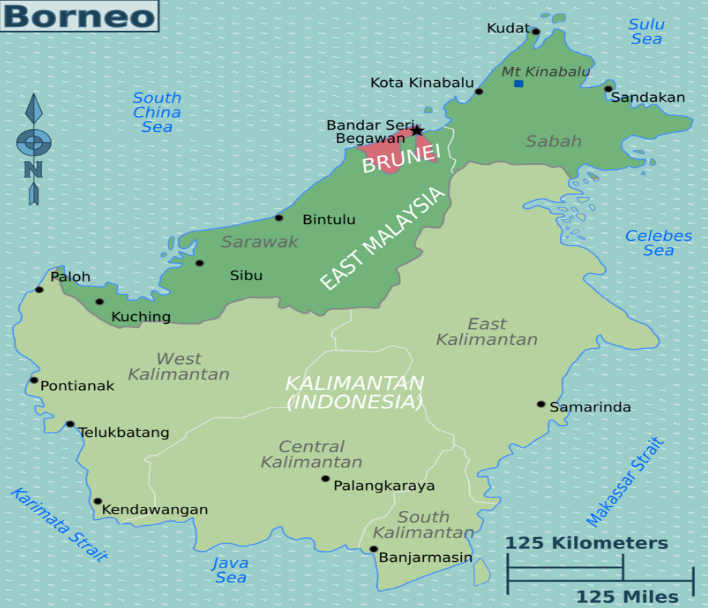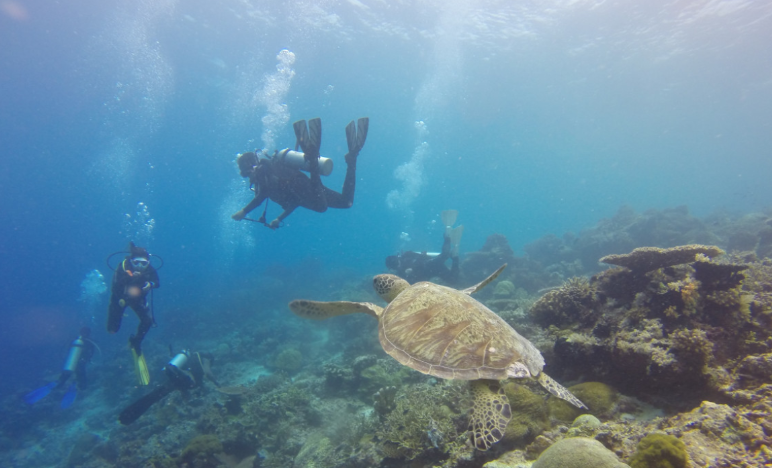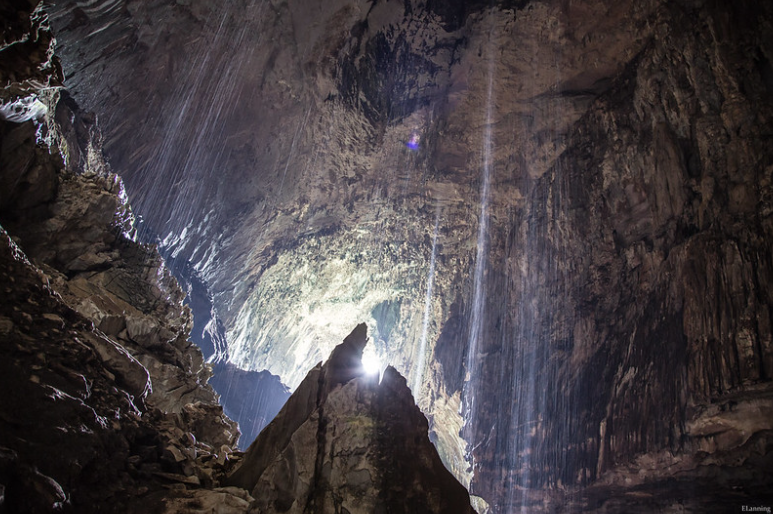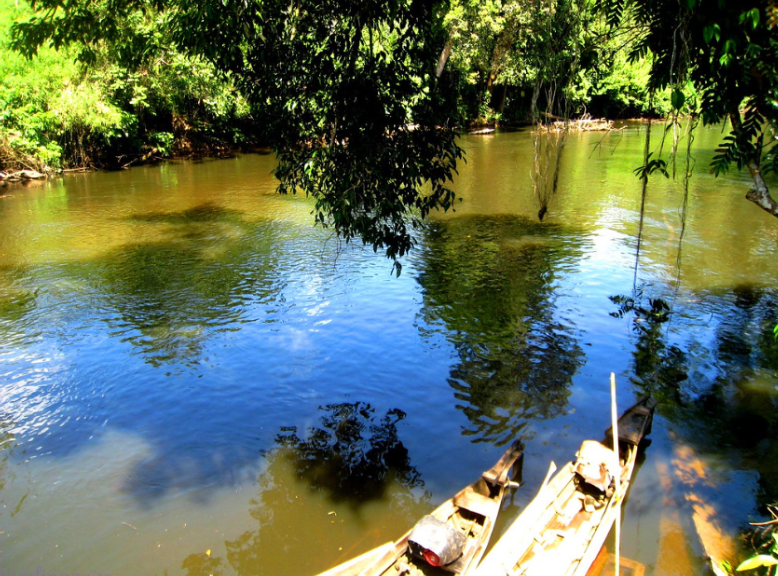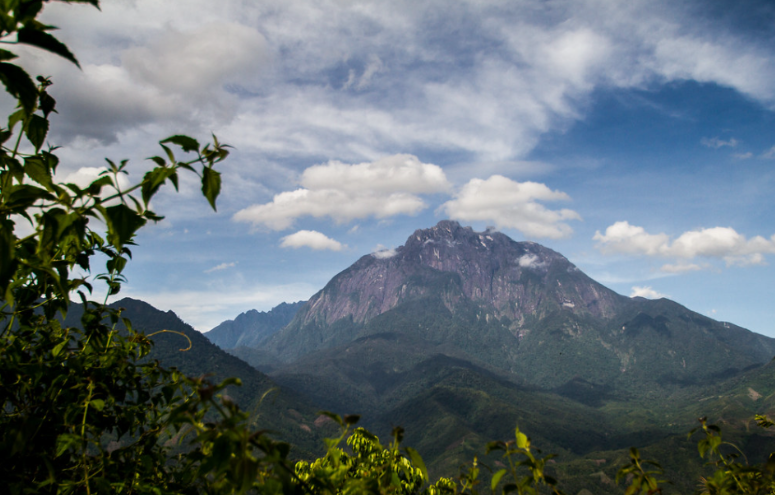Get excited for International Dark Sky Week by exploring a few of the best stargazing destinations the world has to offer.
Read More8 Reasons to Visit Oman
Oman is truly a feast of the senses—a remarkable getaway for anyone seeking a fulfilling adventure.
The Grand Mosque in Muscat, Oman. Madison Paulus
After returning from study abroad in Oman, I have a newfound admiration for the country’s history, culture, views and activities. The vitality of Omani culture despite outside influence is admirable and I could see it reflected everywhere I went. From the very first day, I felt welcomed and immersed within the Omani lifestyle. This trip was an incredible experience, inspiring me to share eight reasons why you should experience Oman.
1. Rich History
View of a mosque from the Nizwa Fort. Madison Paulus
Oman is the oldest independent nation in the region, brimming with about 1,000 well preserved historical sites. While civilization in Oman began around 100,000 years ago, many popular historical sites came about during Portuguese occupation between 1507 and 1650.
In Muscat, the capital of Oman, explorers can find several forts. The Muttrah Fort, which the Portuguese built in 1507 can be found at the heart of Muscat's coast. Here, travelers can gaze upon 500-year-old lookouts.
The Mutrah Fort serves as a vantage point for travelers as it is nearby several other must-see spots, including the Mutrah Market, Al Alam Palace and the National Museum of Oman. Many other castles and forts can be found strewn across Oman, including the Nizwa Fort and Jibreen Castle.
2. Fruitful Culture
A man making pottery at the Jibreen Castle. Madison Paulus
Oman boasts an impressive blend of cultures. The Omani empire once ruled an area spanning from the east coast of Africa up to present-day Oman. Because of the vast territory and major role in trade, African, Arabian and Asian influences can be found embedded within Omani culture.
Home to more than 130 various types of traditional dances and music, Oman’s performance arts delight travelers and locals alike. Omanis are also expressive through their dress. Women can often be seen in vibrant clothing featuring intricate designs that are unique to each region. Men wearing dishdashas dot the streets, sometimes sporting traditional Khanjars (daggers) on special occasions.
Omani hospitality is another key feature of Omani culture. Omanis are known to be warm and welcoming to travelers, sure to offer friendly interactions and generous gifts for guests including coffee, dates and frankincense. For those searching for opportunities to immerse in Omani culture, there are many festivals open to travelers, including the Muscat Festival and the Salalah Festival.
3. Culinary Diversity
A variety of spices at the Nizwa Market. Madison Paulus
As with the culture, Omani food features Arabian, Asian and African influences. Some renowned Omani dishes include Shuwa, Rukhal bread and Halwa. Shuwa is a unique dish saved for special occasions. Meticulously prepared, Shuwa consists of meat cooked in a clay oven underground for up to two days, giving way to a tender, spice-filled delicacy.
Rukhal bread is a delightful addition that can be found accompanying any meal. Traditionally cooked over flaming palm leaves, Rukhal bread is round and thin, often served with honey or date syrup in the morning or sprinkled across meat and rice dishes throughout the rest of the day.
Halwa is a labor of love, often symbolic of Omani hospitality. A sticky, gelatinous treat, Halwa is usually made by combining water, ghee, corn flour, sugar and additional flavorings such as rose water or saffron in a large copper pot. Beyond the restaurants and markets, an ideal place where explorers can indulge in Omani cuisine is the Muscat Eat Food Festival.
4. Unique Commodities
A display of Amouage perfume at the Mall of Oman. Madison Paulus
With an abundance of frankincense and other natural resources, Oman is home to many exceptional goods. Fragrances in particular are an Omani specialty, and Amouage is an exhibition of this expertise. A popular Omani luxury fragrance brand, Amouage draws from Oman’s natural wonders to create enchanting scents, incorporating locally sourced rock roses, ambergris and frankincense.
While the products aren't budget friendly for many people, travelers can tour the only Amouage factory in the world for free in Muscat, getting a behind-the-scenes look and while sampling their extravagant fragrances along the way.
If perfumes aren’t your thing, the smell of burning frankincense and oud can be experienced all over the country. For those who wish to bring the essence of Oman home with them, these products, along with traditional burners, can be found easily at shops and markets.
5. Vibrant Art
Hand-woven baskets on display at the Nizwa Market. Madison Paulus
Many art forms have been intertwined with Omani culture for thousands of years. Pottery is a 5,000-year-old tradition in Oman that is still present across the country. Holding great historical value, pottery has been integral in the lives of Omanis for thousands of years.
While pottery today is often decorative, its historical and cultural value has been maintained here. In the ancient Omani state of Bahla, explorers can buy pottery from local sculptures or even learn how to make their own at the Al Adawi factory.
Other intriguing Omani handicrafts include basket weaving and silversmithing. Hand-woven baskets made of date palm or other natural fibers can be found in markets across the country, and travelers can witness the process in action at the Nizwa Fort. Silver goods like khanjar (daggers) and jewelry can also be found throughout Oman’s markets, symbolic of Omani heritage and good fortune.
6. Comfortable Climate
A view of the landscape from atop the Nizwa Fort. Madison Paulus
Oman’s weather and climate vary significantly by region, easily accommodating travelers’ preferences. With the interior's dry deserts surrounded by southwest summer monsoons and hot, humid coastlines, Oman offers a warm getaway whether you like sun or rain.
Because of this variation, Oman is a year-round destination, with northern Oman attracting many during the months of October through April, and the South drawing explorers most during July, August, and September, according to a presentation by Zahara Tours.
7. Natural Wonders
Camels sit in the sand outside the Arabian Oryx Camp. Madison Paulus
Oman’s ecosystems feature a huge diversity of plants and animals, from rock roses and apricots to turtles and camels. With 20 official nature reserves, travelers are offered a wide array of destinations to appreciate Oman’s natural beauty from the mountains to the sea.
Some iconic destinations for explorers to witness nature at its finest include the Al Jinz Turtle Reserve and Daymaniyat Island, where you can swim with whale sharks as they migrate south every summer.
With several caves beneath the earth and many wonders like waterfalls and valleys above, Oman’s astonishing ecology is situated in equally breathtaking natural landscapes.
8. Adventurous Activities
A Dhow boat sailing in the Gulf of Oman. Madison Paulus
Travelers itching for activity have countless options in Oman. Hikers will feel right at home, with many trails at varying levels of difficulty found throughout the Hajar and Musandam mountains.
Travelers can also explore the desert on camel-back or by riding on ATVs. The Arabian Oryx Camp is a perfect spot for either, in addition to offering Bedouin-style accommodations and authentic Arab cuisine.
For those who prefer to spend time in the water, Oman’s nearly 1,300 miles of coastline offers beaches where travelers can swim and snorkel through blue waters.
Madison Paulus
Madison is a student at George Washington University studying international affairs, journalism, mass communication, and Arabic. Born and raised in Seattle, Washington, Madison grew up in a creative, open-minded environment. With passions for human rights and social justice, Madison uses her writing skills to educate and advocate. In the future, Madison hopes to pursue a career in science communication or travel journalism.
Underwater Paradise: Raja Ampat, Indonesia
With over 70% of the Earth covered by water, it’s only logical for the planet’s greatest beauty to lie beneath the waves. Raja Ampat holds a special place in the hearts of divers and naturalists alike.
Wayang Island within Raja Ampat. Elias Levy. CC BY 2.0.
Situated northwest off of Papua, Indonesia’s most eastern island, the Raja Ampat archipelago is heralded as a top-tier site for scuba diving and marine biodiversity. Raja Ampat comprises over 28,000 square miles of ocean and hundreds of cays and shoals still to be discovered. Plate tectonics exposed ancient limestone seabeds to tidal erosion which yielded a series of islands seeming to levitate above the waves. As the archipelago straddles the Earth’s equator, it naturally experiences a tropical climate.
But Raja Ampat’s most signature feature is its sheer scope of species diversity. Home to at least 75% of the world’s hard corals and at least 1,500 different species of fish, Raja Ampat is considered the global epicenter of marine animal diversity. Due to a confluence of warm, shallow water and nutrient-rich currents from the Pacific and Indian oceans, Raja Ampat has thrived for decades as a haven for endangered aquatics. A slew of rare sea species from dugongs and blue whales to dolphins and leatherbacks live in relative geographic isolation and pristine marine ecosystems.
Northern Raja Ampat
Marine biodiversity is unmatched within Raja Ampat. Nazir Amin. CC BY 2.0.
The northern islands of Gam, Kri, Waigeo and Batanta are bounded by the Dampier Strait. It serves as a popular entryway to Raja Ampat thanks to the city of Sorong on the west coast of Papua which hosts its own airport. With mainland access via ferries, most visitors flock to the north to dive at famous sites such as Cape Kri, Blue Magic and Manta Sandy.
Cape Kri is a renowned hotspot for marine biodiversity. Once recorded as the site with the highest quantity of distinct fish species observed in a single dive, visitors can expect to see reef sharks, moray eels, turtles, Humphead wrasse, cuttlefish, porcupinefish, crevalle jack, snapper and barracuda.
Blue Magic offers a variety of soft and hard coral reefs to check out. Though divers will face strong currents in the water, the struggle is worth the chance to meet dogfish tuna, giant trevally, spanish mackerel, bumphead parrotfish and even octopi.
Manta Sandy is a shallow site teeming with plankton, and of course, ocean manta rays. Divers must try their luck to encounter the rare black manta.
South Raja Ampat
A Wobbegong shark. Nazir Amin. CC BY 2.0.
South Raja Ampat is noticeably inaccessible to the lay visitor as overnight ferries must be taken from Sorong to reach this remote area. However, the reefs in South Raja Ampat are picturesque, with premier visibility for pygmy seahorses, colorful nudibranchs and other wowing wildlife.
The island of Misool is the pinnacle of biodiversity conservation, as much of the area is protected as part of the Misool Marine Reserve. There’s only one option for overnight lodgings: the Misool Eco Resort, an eco-friendly hotel dedicated to conservation and sustainability. The resort’s founders dedicate a portion of both their profits towards biodiversity recovery; there’s been a 250% increase in local biomass and a doubling of reef fishes within six years. Visitors are welcome to trek or boat to neighboring islands for beautiful beaches, native seabirds and rock petroglyphs dating back 4,000 years.
Hundreds of reef fish are visible from above the water’s edge. Nazir Amin. CC BY 2.0.
Raja Ampat’s natural beauty belies political and economic trouble.
Though visitors will certainly enjoy Raja Ampat’s scenic environments and exotic wildlife, they may feel the effects of local turmoil.
In 1961 the people of West Papua, an area which includes Raja Ampat, voted to become a part of Indonesia in a much disputed referendum. However, a pro-independence movement has emerged throughout Papua, eliciting police and military crackdowns alongside communal tensions. Furthermore, around 9,000 of Raja Ampat residents live in poverty, lacking sanitation facilities and healthcare. Clean drinking water is imported into the islands approximately once a month; there is no electrical or telecommunications infrastructure available for most villagers. Most inhabitants either fish or mine to earn their living, and often incur debts to small businesses for consumer goods and fuel prices. Raja Ampat’s ecotourism industry is partnering with local residents to promote their security and welfare.
Rohan Ratogi
Rohan is an engineering graduate from Brown University. He is passionate about both writing and travel, and strives to blend critical thinking with creative communication to better understand the places, problems, and people living throughout the world. Ultimately, he hopes to apply his love for learning and story-sharing skills to resolve challenges affecting justice, equity, and humanity.
10 Unique Sports Around the World
From Senegal to Southeast Asia, here are lesser-known sports entrenched in cultural traditions.
African Wrestling World Tour opening, Pierre-Yves Beaudouin, CC BY-SA 3.0, via Wikimedia Commons
Standing up in your seat at Croke Stadium in Dublin screaming “Let it in!” with tens of thousands of other Hurling fans is among the most Irish experiences you can have. However, this kind of experience isn’t unique to Ireland. Whether it’s wrestling in Senegal or canal jumping in the Netherlands, sports often have huge cultural significance, providing people with entertainment and reasons to get together. While we usually only hear about a select few, there are thousands of sports around the world, many with fascinating histories and passionate fanbases. Below are ten of the most interesting lesser-known sports and the histories behind them.
1. Stickball—Native American Nations
Kullihoma Stickball Tournament, Choctaw Nation, CCO 1.0, via Wikimedia Commons
According to an Iroquois legend, a Chief and a young woman living in the sky world had to marry to save their universe. Before they could, however, a stickball player traveled through the multiverse, saving the woman and impregnating her before they reached Earth, leading to the spread of humanity.
Stickball has been played by the Indigenous Nations of the Iroquois Federation, the Chickasaws, and the Choctaws since 1100 AD. Previously known as the “little brother of war,” stickball was used as a way to settle a conflict. Today, it is best known as the predecessor to modern lacrosse. The main differences between lacrosse and stickball are that traditional stickball often pits men against women and a pole is used instead of a goal.
Stickball is still played throughout native communities, with the most recent World Series Stickball Championship taking place on July 15 and 16, 2022 at the Choctaw Indian Fair on the Choctaw Indian Reservation in Mississippi.
2. Hurling—Ireland
The average NBA basketball game attracts between 15-20,000 fans per game. Every year the All-Ireland Hurling Finals is played at Croke Park stadium in Dublin, with over 80,000 fans in attendance.
The first reference to hurling was from 1272 BC, making hurling over 3000 years old. Hurling has had a huge role in Irish history and society, so much so that the Brehon Laws, the native Gaelic legal system, used to give out compensation to players injured through hurling.
Currently, hurling is run with strict rules by the Gaelic Athletic Association (GAA). It is played with a stick known as a hurley and a ball called a sliotar. By using a combination of your hand and the hurley, the object of the game is to get the sliotar into the opposing team's net.
3. Capoeira—Brazil
Capoeira at the Brazilian Pavilion at Folklorama 2013, Ccyyrree, CC0, via Wikimedia Commons
From its inception, the half-martial-art half-dance Capoeira was a symbol of hope and freedom. The original elements of Capoeira were brought to Brazil by enslaved people from Africa and practiced on plantations as a way of maintaining their traditional culture. Due to Brazil’s large size, runaway slaves were often able to escape and form their own communities, called Quilombos. It is thought that it was here that Capoeira was truly able to develop and evolve.
In the present day, you don’t need to go to Brazil to practice Capoeira. The World Capoeira Federation is located far away in Tallinn, Estonia, and there are Capoeira studios in many countries around the world.
4. Kabaddi—South Asia
Iran’s Kabaddi Team, Fars Media Corporation Amir Hosseini, CC BY 4.0, via Wikimedia Commons
Siddhartha Guatama, the Buddha himself, is recorded in Buddhist literature to have played Kabaddi recreationally. It may seem surprising that the Buddha, famous for his calm and peace-loving nature, played a contact sport, but this connection makes more sense than it seems. In both Kabaddi and meditation, breath is of central importance.
Kabaddi has two teams, each based in one half of a field. Play starts when a “raider” runs to the other side and attempts to tag their opponents. During the entire raid, the player must hold their breath, and continuously yell “Kabaddi” to prove they are not breathing. If the player makes it back to the other side, they will get a point for every opponent they touched. If they do not and are wrestled down, then the opposing team gets a point.
Currently, Kabaddi is the national sport of Bangladesh and is popular throughout South Asia, where the Vivo Pro Kabaddi League hosts matches every year.
5. Senegalese Wrestling—Senegal
African Wrestling World Tour, Pierre-Yves Beaudouin, CC BY-SA 3.0, via Wikimedia Commons
Laamb en Wolof, widely known as Senegalese wrestling, is deeply rooted in tradition. Historically, people of the Sérère and the Diola ethnicities used wrestling at the end of harvest season to determine who would be the village champion, winning cattle and other important prizes. Today, each match starts with the fighters being introduced by a chorus of women known as a Baccou.
Senegalese wrestling differs from Western wrestling in its rules. In Senegalese wrestling, you can punch the body and head with your bare fists. A match ends whenever a wrestler falls and his back touches the ground.
Currently, Senegalese wrestling is very popular in West Africa and the national sport of Senegal, where it rivals soccer in popularity.
6. Sepak Takraw—Southeast Asia
Sepak Takraw, Korea.net / Korean Culture and Information Service, CC BY-SA 2.0, via Wikimedia Commons
Played throughout Southeast Asia, Sepak Takraw is, in essence, volleyball played without your arms. To serve, professional players usually do a bicycle kick, trying to slam the ball down into the opponent's court. Players use their bodies to block shots.
Sepak Trakaw was first played by Malaysian royalty about 500 years ago. From there, in the 16th century, it expanded throughout the Indonesian archipelago under the name Sepak Raga. In 1945 a swim club hosted the first official Sepak Raga tournament. More and more tournaments were played until in 1992, the game was formalized under its current name by the International Sepaktakraw Federation.
7. Donkey Racing—Kenya
Lamu Donkey Races, Kayak Aberfeldy, CC BY-NC-ND 2.0 via wordpress.org
On the small Kenyan Island of Lamu, cars and bicycles are banned, allowing the people of Lamu and their visitors to maintain their traditional form of transportation: donkeys. Every year around November, the over 700-year-old township hosts its annual Lamu Cultural Festival. Taking place in a UNESCO World Heritage Site, Lamu Old Town, the star of the festival is always the annual donkey race.
Similar to a marathon, anyone interested is allowed to participate in the donkey race, and many tourists fly in to compete. The race is quite competitive, as the winner usually earns a significant cash prize and a trip to Nairobi.
8. Kho Kho—India
Kho Kho Game in Haryana, Mester Jagels (Jasper van't Veen), CC BY 2.0, via Wikimedia Commons
The first mention of Kho Kho is believed to be in the about 2,000-year-old Indian Epic Mahabharata. The epic described how on the 13th day of the war, to break the impenetrable defense Chakravyuha, the hero Abhimanyu used tactics very close to ring play, the modern-day defense used in Kho Kho.
Kho Kho is a version of tag, where over two nine-minute innings teams take turns being both the chasers and defenders. The chasers work as a team to catch the defenders as quickly as possible. Whichever team catches the other in less time wins. Kho Kho had its first major tournament in 1996 with the Asian Kho Kho Championship in Kolkata.
9. Fierljeppen—The Netherlands
Fierljeppen in Linschoten, Peter van der Sluijs, CC BY-SA 4.0, via Wikimedia Commons
Fierljeppen, or “far leap” in Frisian, is the sport of canal jumping native to the province of Friesland in the Netherlands. An extreme alternative to traditional pole jumping, competitors use a large pole called a polsstok to launch themselves across a river. Presently, the Netherlands has over 600 registered jumpers. The current world record is 22.21 meters.
When Fierljeppen was first recorded in the 1200s, it was practiced not as a sport but rather as a method of transportation. The Netherlands had a lot of canals and very few bridges, meaning, if you wanted to cross the Netherlands, you’d have to use a pole to vault over the waterways. It wasn’t until 1767 that Fierljeppen was hosted as an official competition.
10. Arnis—The Philippines
Arnis International, Cisc1970, CC BY-NC 2.0 via wordpress.org
In 1521, the Spanish Ferdinand Magellan brought forces armed with muskets to colonize the Philippines. Armed with only bladed weapons, the Indigenous Filipino islanders defeated the conquistadors through the use of their native martial art Arnis.
Today, Arnis is the national martial art and sport of the Philippines. The most famous part of Arnis is its stick fighting competitions. There are two models of competition: the performance Anyo model, which judges you on choreography and grace, and the combat Leban model, which focuses on the number of hits landed on your opponent. In May 2023, for the first time outside of the Philippines, the Southeast Asian games in Cambodia are slated to include Arnis.
Jeremy Giles
Jeremy is a Writing Seminars and International Studies major at Johns Hopkins University. He is an avid writer and the Co-Founder of Writers’ Warehouse, Johns Hopkins’ first creative writing group. He is an advocate for Indigenous rights, and studies how Indigenous philosophies can be used to help prevent climate change. Using his writing, he hopes to bring attention to underrepresented voices in today’s world.
A Literary Pilgrimage: Colombia with Gabriel García Márquez
A travel itinerary for bibliophiles, Gabo fans and adventurers alike
Author Gabriel García Márquez, “Gabo,” as an older man. Sebástian Freire. CC BY-SA 2.0.
Author Gabriel García Márquez, affectionately nicknamed “Gabo,” put his native country of Colombia on the literary map through his novels and short stories.
Critics lauded his novel Love in The Time of Cholera, a tale of romance between social classes, as one of the best love stories of the 20th century. His work One Hundred Years of Solitude, a multi-generational novel about a family from an isolated town, is considered the Bible of magical realism, a genre that describes fantastical events in an otherwise realistic tone.
Adventurous travelers and bibliophiles alike can experience the magic and romance of Colombia through García Marquez's eyes with an itinerary based on his life and literature.
A colorful street scene in Cartagena’s historic center. Joe Ross. CC BY-SA 2.0.
1. Cartagena
In an interview with actor and filmmaker Salvatore Basile, García Márquez said, “I would say that I completed my education as a writer in Cartagena.” With that in mind, Caribbean-flanked Cartagena is the ideal place to begin your Gabo-inspired tour of Colombia.
García Márquez lived in Cartagena for a year as a young man and kept a winter house in the city as an older man. He sets much of Love in The Time of Cholera in Cartagena. During his time in Cartagena, he was known for lingering on the plazas, waiting for something interesting to happen.
To experience the city from Gabo’s perspective, people watch at the lush, lively Plaza Fernandez de Madrid and historic, central Plaza Bolivar. Grab a drink at El Coro, the upscale cocktail bar in The Sofitel Santa Clara hotel, which García Márquez frequented. Visit Gabo’s marble-clad final resting place at La Merced monastery on the University of Cartagena’s campus.
The orange-tinted cityscape of Barranquilla. Fernando Orozco. CC BY-NC-SA 2.0
2. Barranquilla
Following Gabo’s footsteps, travel from Cartagena to Barranquilla, a seaport known as Colombia’s “Golden Gate" because here the Caribbean meets the country’s major Magdalena River. Gabo lived here in the 1950s while he worked as a journalist.
While living in Barranquilla, García Márquez was a part of the Barranquilla Group, a collection of writers, journalists and philosophers who met Barranquilla in the mid-twentieth century. In addition to García Márquez, notable members include Álvaro Cepeda Samudio, Germán Vargas and Alfonso Fuenmayor. Allegedly, Gabo’s relationship with these men inspired the characters of the “four friends of Macondo” in One Hundred Years of Solitude.
Connect with Gabo and his Barranquilla Group friends at La Cueva, a bar where the Barranquilla Group of writers and journalists met. It continues to serve as a hub of cultural activity, serving traditional food like Butifarra ceviche and Cashew rice, as well as supporting Colombian literary magazines. Tour the peach-colored church, Iglesia Nuestra Senora del Perpetuo Socorro, where Gabo married his wife Mercedes Barcha.
The Casa Museo Gabriel García Márquez, Gabo’s childhood home. Armando Calderón. CC BY-NC-ND 2.0.
3. Aracataca
After connecting with García Márquez’s early days as a writer in Barranquilla and Cartagena, go back to where it all began in Aracataca: Gabo’s steamy, sleepy and tropical hometown. Gabo’s success put Aracataca on the map, rejuvenating the town as small groups of literary tourists trickled in to see where a genius grew up. You can meander through the white house and its verdant garden where García Márquez lived until he was eight, Casa Museo Gabriel García Márquez.
In addition to being the locale of Gabo’s childhood, Aracataca inspired Macondo, the setting for One Hundred Years of Solitude. Stop for a photo opportunity in front of Aracataca’s bright, multicolored welcome sign, which includes an equally vivid Macando welcome sign in smaller letters.
Walking the streets of La Candelaria neighborhood in Bogotá. Michael Barón. CC0.
4. Bogota
Conclude your tour of Gabo’s Colombia in mountainous Bogota. While not Gabo’s favorite city in Colombia, he called it “a remote, lugubrious city where an insomniac rain had been falling since the beginning of the sixteenth century” in his autobiography—it played a crucial role in his education.
García Márquez attended secondary school and earned a law degree in Bogota. He published his work in the city’s newspaper El Espectador. He also lived here temporarily with his wife later in his life, in the colonial neighborhood La Candelaria.
Learn more about his work and life at the Centro Cultural Gabriel García Márquez, a museum and hub of artistic activity in a circular building with its roof offering views of Bogota’s mountains and cityscape. Sip a coffee at Cafe Pasaje, an old-school coffee shop where Gabo allegedly had his java each day when he was a young journalist.
Annie O’Brien
Annie is a third-year student at George Washington University studying English, Creative Writing, and History. From Philadelphia, she is an avid reader, pop-culture enthusiast, and traveler. She’s always eager to talk about her adventures abroad and domestically, whether it's telling about the time she hitch-hiked in Bavaria or offering recommendations for the best bookstores in Key West. She hopes to become a published author one day. Enjoy more of her writing on her Substack.
Fairies and Folklore: The Magic of Scotland and England
From castles to coves, uncover destinations steeped in the mythological histories of Scotland and England.
Portree, Isle of Skye’s capital city. CC BY 3.0
Whether your knowledge of fairies comes from nostalgic childhood tales or the well-informed worldbuilding of Tolkein, much of the folklore that has made its way into the popular imagination is embedded deep within the rolling hills of Scotland and England.
While each country has its variations of the myth, taking a tour through the whimsical high grassed countryside and rocky shores is a great way to take in some awe-inspiring views and understand the magic embedded in these countries.
Scotland
Located off of Scotland's northwest coast, the Isle of Skye is full of picturesque villages, cliffed shores and quaint fishing towns. But rather than only enjoying the colorful coastal houses on Portree, the island's capital, extend your adventure and visit various sights around the island boasting mythical pedigrees.
Fairy Pools
A waterfall at the Fairy Pools on the Isle of Skye. CC BY 3.0
A waterfall phenomenon in Glen Brittle, the falls are surrounded by sky-capped mountains and boast aqua-blue waters of astonishing clarity. Some claim if you’re lucky, you may spot a fae or two amongst the willowing grasses and purple flowers; if not, the red deer, sheep, and rabbits inhabiting the area will have to suffice.
The pool's name comes from the local legend that claims a Clan McLeod Chief married a fairy Princess. Additionally, the pools are said to attract selkies, a group of mythical creatures that spend the day on the coast as seals and then enjoy the pools at night after transitioning to human form.
Despite their charm, the Fairy Pools feature some brutally cold water temperatures, although it may be worthwhile to take a dip; as locals say, holding your head underwater for seven seconds is enough to bless you with the gift of eternal youth.
From the capital city of Portree, the Fairy Pools are a 35-minute drive and can be accessed through various tours operating on the island or of your own volition. The Fairy Pools walk is a 1.5-mile, easy hike to the pools from the parking lot.
Dunvegan Castle and Gardens
The Dunvegan Castle. CC BY-NC-ND 2.0 DEED
Open from March 29 to October 15, the Dunvegan Castle and Gardens is a medieval fortress dating back to the 1200s. Occupied by the same family for the last 800 years, the Hebridean castle is home to a few pieces of myth. On the Dunvegan property, one can walk across Fairy Bridge while exploring the grounds and even see the Fairy Flag, which is housed in the Castle.
The Fairy Flag is the prized silk scarf woven in the 4th century AD, either in Syria or Rhodes, and is said to possess miraculous powers instrumental in MacLeod’s battle victories. While there are two points of origin, a fairy origin and a crusader origin, the Fairy Bridge and Tower versions give the flag roots in folklore.
The Fairy Tower myth tells the tale of a restless MacLeod chief’s baby who was comforted one night by a fairy. The Fairy Bridge myth relates to the previously mentioned story of the MacLeod Chief and Fairy Princess; the story goes that the two parted ways on Fairy Bridge at Dunvegan, and the banner was his gift.
An astounding horticultural destination, Dunvegan boasts multiple gardens and woodland trails. The landscape and fauna are a wonder unto themselves. The gardens also feature lily ponds, gazebos and rare artifacts, such as a 17th-century sundial.
Located a 30-minute drive from Portree, the castle makes for an excellent excursion when visiting Scotland. While the Dunvegan Castle and Gardens offers visitor tours daily and make for a great day trip, the property's five holiday cottages allow visitors to enjoy an enchanting multi-day stay on the secluded property.
Fairy Glen
The labyrinth and peak at Fairy Glen on the Isle of Skye. CC BY NC-2.0
Protruding from the surrounding farmlands, Fairy Glen is a geographical landscape formed by an ancient landslide. The craggy formations and valleys are blanketed by a lush layer of green and are rumored to be home to the fae.
Climbing up Fairy Glen’s peak or walking beneath the cover of moss-engulfed trees will make anyone feel like they are walking amongst the faeries. Be sure to stop and make a wish at the stone labyrinth when you are making your way through.
Fairy Glen is about a 25-minute drive from Portree, and various tours include this location as a stop. From the destination's parking lot there is a one-mile walking circuit that showcases the grounds, but feel free to adventure on your own and enjoy this majestic landscape.
England
On the rugged Southwestern tip of England, Cornwall is home to many of the country's mythical and folktales. Cornwall has its own variety of fairies, the Piskeys, a lively and mischievous people who originated from tales of a Pygmy race in Cornwall during the Neolithic period. More than just fairies, Cornwall is rumored to be home to mermaids, giants, and various King Arthur myths.
Sennen Cove
The coastline and surrounding shore at Sennen Cove. CC BY-SA 4.0 DEED.
England’s most westerly beach, Sennen Cove, is a white sand beach renowned for its excellent surfing conditions. In the early 20th century, American Anthropologist Walter Evan Wentz published "The Fairy Faith In Celtic Countries", conducting some of his research at Sennen Cove by speaking to locals about the dancing fairies. A study published at a similar time in the Journal of the Society for Psychic Research tells the story of Grace Penrose as written by E. Westlake. She speaks of miniature people in white dancing in the moonlight before being frightened and disappearing into a rock face along the shore.
To get to Sennen Cove, visitors can take a bus that leaves every two hours from Penzance or make the 20-minute drive themselves. Once at the Cove, you can enjoy Whitesands Bay, the stretch of white sand beach on the Cove’s coast. Overlooking the cove, stop at the Old Success Inn, a pub dating back to the 17th century, for lunch and drink. The Inn has a rich history in Sennen Cove and is rumored to be a site for mermaid sightings.
Elusive in nature, when visiting Sennen Cove, you may not stumble upon any fairies in the moonlight or catch a glimpse of mermaid tales ducking under the blue waves, but the Cove is perfect for a beach getaway anyway.
St. Michael’s Mount
The castle and causeway leading up to St. Michael’s Mount. CC BY-SA 3.0 DEED
A tidal island in Cornwall’s Mount Bay, St. Michael’s Mount is home to one of England’s most famous legends. Rumors of mermaids luring sailors to the island’s shores date as far back as 495 AD, but even more prominent is the Cornish tale of Jack the Giant Killer. With the island as his home, the evil Cormoran was defeated by none other than Jack after a long reign of terror. Per the legend, when visiting, be sure to hike up the mountain and around the island in search of the giant's missing stone heart.
Outside of folklore, the site is also a religious destination. Archangel Michael was rumored to have guided sailors to safety at the current location of the castle’s entry. Named after that patron saint of fishermen, St. Michael’s causeway allows travelers and pilgrims alike to walk from the mainland to the island during low tide.
To reach the island, walking over the causeway is one option; however, if it happens to be high tide, from March 29 to October 31 there are boats running from Marazion Beach to the island. Riddled with history, the castle, church and surrounding gardens offer a fusion of folk and faith, making Mount St. Michael a beautiful, enchanting destination on a Celtic fairytale tour.
Nicola is studying English Literature at George Washington University, where she also reports for the student newspaper, The Hatchet. Nicola's passion for literature and writing has sparked an interest in exploring the broader context surrounding written texts. Researching and writing for Catalyst Planet allows her to investigate nuanced issues that intersect with her interests in art history, culinary practices, and cultural traditions.
Nicola is studying English Literature at George Washington University, where she also reports for the student newspaper, The Hatchet. Nicola's passion for literature and writing has sparked an interest in exploring the broader context surrounding written texts. Researching and writing for Catalyst Planet allows her to investigate nuanced issues that intersect with her interests in art history, culinary practices, and cultural traditions.
Nicola is studying English Literature at George Washington University, where she also reports for the student newspaper, The Hatchet. Nicola's passion for literature and writing has sparked an interest in exploring the broader context surrounding written texts. Researching and writing for Catalyst Planet allows her to investigate nuanced issues that intersect with her interests in art history, culinary practices, and cultural traditions. Nicola is studying English Literature at George Washington University, where she also reports for the student newspaper, The Hatchet. Nicola's passion for literature and writing has sparked an interest in exploring the broader context surrounding written texts. Researching and writing for Catalyst Planet allows her to investigate nuanced issues that intersect with her interests in art history, culinary practices, and cultural traditions.
Nicola Degregorio
Nicola is studying English Literature at George Washington University, where she also reports for the student newspaper, The Hatchet. Nicola's passion for literature and writing has sparked an interest in exploring the broader context surrounding written texts. Researching and writing for Catalyst Planet allows her to investigate nuanced issues that intersect with her interests in art history, culinary practices, and cultural traditions.
Graffiti Capitals: 9 of the World’s Best Cities for Street Art
From Argentina to Estonia, artists around the world commemorate and contribute to city culture through street art.
Street art by Cabaio Stencil in Bueno Aires, Argentina. Parisa. CC BY-NC-SA 2.0
1. Bogota, Colombia
Street art in Bogota, Columbia. McKay Savage. CC BY 2.0
Lying in the east Andes mountains, Colombia’s capital Bogota is home to blocks of mural-covered walls. While graffiti has been decriminalized since 2013, the road to get here was violent. In 2011, 16-year-old Diego Becerra was shot and killed by police for spray painting, causing an uproar among Bogota’s residents.
The following advocacy to decriminalize spray painting was successful. The government’s relationship with street art continued to evolve after Justin Bieber visited Bogota in 2013 and was allowed to spray paint with police protection. The hypocrisy of giving special license and support to the Canadian singer spurred further advocacy, and now Bogota’s government actively promotes spray painting and other forms of street art.
Today, travelers can revel in Bogota’s street art throughout the city, from the airport to downtown. Some must-see destinations include Distrito Graffiti, an industrial area where two whole blocks are decorated with vibrant paint, and La Candelaria, Bogota’s historical quarter featuring murals strewn throughout storefronts and parks.
2. Buenos Aires, Argentina
Street art in Buenos Aires, Argentina. Wally Gobetz. CC BY-NC-ND 2.0
Home of the record-breaking mural spanning over 20,000 square feet, Buenos Aires boasts a flourishing street art scene thanks to minimal restrictions and generally supportive attitudes.
Stimulating murals dot the Argentine capital from north to south. Here, artists use cityscapes as a canvas to pay homage to their history and culture through vibrant and satirical murals.
Travelers have access to a variety of ways to take in these works of art, from strolling about to partaking in self-guided or private tours. For those with tight budgets yearning to experience some of these masterpieces, there are several online exhibits only a click away.
3. Cape Town, South Africa
Street art in Cape Town, South Africa. Tsn92. CC BY 2.0
Situated among mountains on the Atlantic Ocean, Cape Town has a history drenched in creativity in spite of longstanding adversity. Areas like District Six maintained vibrant cultural and artistic diversity throughout Apartheid, while some areas such as Woodstock have had a post-Apartheid revival.
During the 1980s, Cape Town's graffiti culture materialized as a tool to resist apartheid, with artists like Falko One using their street art to address injustice. Despite 30 years having passed since the collapse of the Apartheid regime, segregation and inequity persist alongside the street art calling attention to them.
In February 2024, the eighth International Public Arts Festival took place in Cape Town. Each year, the festival offers locals and explorers alike an opportunity to immerse themselves in Cape Town’s street art culture.
4. Lisbon, Portugal
Street art in Lisbon, Portugal. Pedro Ribeiro Simões. CC BY 2.0 DEED
The evolution of Lisbon’s street art is exceptional, transforming a city with predominantly white buildings into one renowned for its color-filled streets over the past three centuries.
Color began to be incorporated into building designs during the 1750s, and street art as we know it today didn’t appear until the democratic revolution in 1974. Meanwhile, an even deeper past lies underneath the streets in the 2,000-year-old Roman Galleries, where visitors can find ancient inscriptions on the tunnel walls.
Now, buildings across the city serve as canvases for artists, with many spanning several stories. Lisbon street artists don’t limit themselves to spray paint. Artists such as Vhils and Bordalo II get creative with their methods, incorporating chiseling techniques and found objects into their work.
5. Lodz, Poland
Street art in Lodz, Poland. Aira. CC BY-NC-SA 2.0
Often referred to as the capital of Polish street art, Lodz is a city with a rich history in the arts, gaining recognition over the years for its audiovisual arts scene ranging from fashion to film.
Many organizations have taken initiatives to support and expand street art in Lodz. Since 2009 the Urban Forms Foundation has been at the forefront of Lodz's street art movement. This organization offers advice to urban artists while maintaining the Urban Forms Gallery, a collection of creatively coated walls intended to bring life and recognition to the community.
Local street artists like M-City and the Etam Crew enhance the landscape with murals in styles ranging from futurism to realism. Lodz draws urban artists from around the world, with the Urban Forms Gallery project engaging artists from eight countries.
6. Penang, Malaysia
Street art in Penang, Malaysia. Mohd Fazlin Mohd Effendy Ooi. CC BY 2.0
Hundreds of murals drape the skyline of Penang, Malaysia. The street art movement began in 2012 when the Penang Tourist Board commissioned Ukrainian street artist Ernest Zacharevic.
Street art in Penang has since been a means of reflecting community culture and values. Zacharevic’s murals center on local communities and history, and can be seen throughout George Town. In the same city, travelers can also admire pieces like the 12-mural series of stray cats created by local organizations using street art to call attention to issues like animal welfare.
7. Stavanger, Norway
Street art in Stavanger, Norway. Sílvia Darnís. CC BY-NC-SA 2.0 DEED
In Stavanger, Norway, explorers can gaze upon the paradox of traditional architecture contrasted with progressive street art. Here, travelers can find a plethora of urban masterpieces created by world-famous street artists like Banksy and local talent like Algebra.
The dynamic street art scene today can be traced back to the Nuart Street Art Festival. Since 2001, the Nuart Festival has gathered teams of street artists from around the world to collaborate on projects throughout Stavanger. Beyond the creation of new street art, the Nuart Festival contributes to Stavanger’s urban art culture by hosting events, tours and workshops around the city.
For those looking to take a step further into the world of street art, some street artists in Stavanger offer classes.
8. Tallinn, Estonia
Street art in Tallinn, Estonia. Karen Bryan. CC BY-ND 2.0 DEED
Although the emergence of street art in Tallinn, Estonia, is fairly recent, this city has much to offer to travelers seeking masterful creations on city walls. In 2016, an official street art program began, initially centered around street dance, but some initial mural painting provided building blocks for a soon-to-be burgeoning street art movement.
The following year, the Mextonia Festival brought Estonian and international street art into the spotlight. This cross-cultural festival was a gift from Mexico to celebrate 100 years of independence for the Baltic nation. Today, visitors can see collaborative murals from this festival incorporating folk mythology and symbolism. Over 30 murals from the Mextonia Festival dot highways and cover walls throughout the city.
9. Valparaiso, Chile
Street art in Valparaiso, Chile. Gabriel White. CC BY-SA 2.0 DEED
Located on Central Chile’s Pacific Coast and often referred to as the Jewel of the Pacific, Valparaiso Chile is known to be among the most tagged cities in the world. Some murals in Valparaiso created by artists like Roberto Matta date back to the 1960s.
A couple of the best places to view Valparaiso’s breathtaking street art are Templeman Street and the open-air street art museum in Bellavista. Valparaiso’s hilly terrain provides numerous viewpoints for street art gazing.
A unique piece created in 2012 by Inti Castro spans three buildings and can only be viewed from Paseo de Atkinson in Concepcion Hill and Carcel Hill. Castro’s horizontal giant is far from the only street art you can see at Concepcion Hill, which is a great starting point for self-guided tours.
Madison Paulus
Madison is a student at George Washington University studying international affairs, journalism, mass communication, and Arabic. Born and raised in Seattle, Washington, Madison grew up in a creative, open-minded environment. With passions for human rights and social justice, Madison uses her writing skills to educate and advocate. In the future, Madison hopes to pursue a career in science communication or travel journalism.
10 Best Places to Travel in the US this Spring
A guide to the most beautiful spots to experience in the springtime
Read MoreDive into Songkran: The Thai New Year Festival
Want to experience a month-long celebration featuring water battles in the streets and other amazing festivities? Discover the Thai Songkran Festival.
A water fight during the 2015 Songkran Festival in Thailand. Sano Rin. CC BY-NC 2.0
Thousands of international travelers are drawn to Thailand each year to celebrate the Songkran Festival, also known as Thai New Year. Songkran has been celebrated for thousands of years, but this year is special. In 2023, UNESCO (United Nations Educational, Scientific and Cultural Organization) added the festival to the Intangible Cultural Heritage of Humanity list. In honor of this recognition, the Thai government plans to hold Songkran festivities for the entire month of April 2024, instead of the usual three-day period between April 13th and 15th.
The Songkran Festival has evolved over the years. The first recorded reference to the holiday dates back to the 15th century, with some scholars theorizing that it was derived from the Indian Holi Festival. The Sanskrit word for “movement” is the root of the term “Songkran,” which refers to the movement of the sun from the astrological months of Pisces to Aries during April.
Water is a focal point of many Songkran Festival traditions, symbolizing cleansing and good fortune for the coming year. Rod Nam Dam Hua is a tradition in which youngsters pour scented water on their elders' hands to express gratitude. Scented water is also sprinkled on Buddha statues to bring prosperity, and respect for ancestors is shown by bathing their urns. According to some scholars, the notorious water battles began to promote tourism during the 20th century. Other traditions include offering food to Buddhist monks and bringing sand pagodas to local temples to replenish the sand tracked out of the temples throughout the year.
April is the hottest part of the year in Thailand. If you want to beat the heat by getting soaked during the water battles, check out streets like Khao San Road in Bangkok, or other popular walking streets in cities like Pattaya or Chiang Mai. As locals and tourists drench each other with buckets and colorful squirt guns, music and the aromas of street foods like Thai fried chicken (called Gai Tod) fill the air.
If water fights aren’t your thing, April is still a great time to experience Thailand. Travelers can experience a variety of activities from Thai beauty pageants to boat races. Thailand's natural environments boast breathtaking destinations from white sand beaches featuring coral reefs to lush hiking trails. For those yearning to see some historical wonders, Thailand offers ancient destinations like the city of Ayutthaya and the Phanom Rung temple complex. You can then recover from a long day of fun with revitalizing Thai dishes such as beef curried noodles, called Christao Khao Soy Nuea, or Bangkok Glutton Som Tum, a Green Papaya salad.
As Thais gear up for this year's Songkran Festival, it is important for travelers to stay up to date on Covid-related travel protocols and other ways to be respectful during the celebrations. For all the water-loving cultural fanatics, the 2024 Songkran Festival awaits you.
Madison Paulus
Madison is a student at George Washington University studying international affairs, journalism, mass communication, and Arabic. Born and raised in Seattle, Washington, Madison grew up in a creative, open-minded environment. With passions for human rights and social justice, Madison uses her writing skills to educate and advocate. In the future, Madison hopes to pursue a career in science communication or travel journalism.
Journey through the Wind and Waterfalls of South America
A group of friends started a journey to Argentina, Chile, Bolivia, Uruguay, Paraguay and Southern Brazil in their old and rusty Land Rover. They encountered lots of winds, emptiness, pampas, bustling cities, animals, deserts and waterfalls—all wrapped up in just under 6 minutes. Enjoy the ride!
CONNECT WITH VINCENT URBAN
Love is Universal: 7 Romantic Traditions from Across the Globe
Exploring the unique ways different cultures express love.
Read MoreA panoramic view of Choquequirao. Laura Grier
Choquequirao: The Unknown Inca Trail
Deep in Peru's Apurimac Valley, the Incan citadel of Choquequirao exudes an aura of mystery and intrigue, owing to both its challenging journey to reach and its enigmatic history.
Read MoreBeyond the Caribbean, 10 Tropical Escapes the World Over
For those looking to escape frigid winter temperatures, these 10 destinations will satisfy wanderlust while offering tropical climates, beaches, diverse cultures and more.
Read More7 Tombs to Visit Besides the Great Pyramids
The Great Pyramids are probably the world’s most well-known tombs, but they are far from the only ones. These seven tombs are impressive and fascinating.
Read MoreThe Rise of Cat Cafes: Popularity and Pitfalls
While they have a rich history and are fun for humans, cat cafes are a hot topic in animal rights ethics.
Cat in cafe window. Atahan Demir. CC0.
Scooping litter, carpets of cat hair, vet visits and medical bills: taking care of a cat—or any other animal, for that matter—can be both tedious and expensive. But on the other hand, cats are adorable, energetic and entertaining furballs. Previously, there was no in between—if you wanted a cat, it was either all in or nothing. Now there is an in-between solution: cat cafes. Cat cafes serve typical coffee shop beverages and pastries with the added bonus of being able to spend time with a variety of cats and kittens. Often cat cafes charge based on time spent at the cafe, with most cafes having set rates for either 30 minutes or one hour with the cats.
Although cat cafes are currently immensely popular, at one point they weren’t the global phenomenon they are today. The first cat cafe, Cat Flower Garden, was founded in Taipei, Taiwan in 1998. Although there were other cafes to house cats prior to Cat Flower Garden, they were the first cafe to market themselves specifically as being a cat cafe. Now, people from both Taiwan and around the world not only come to play with their fifteen in-house cats, but also to ask for business advice. When Cat Flower Garden first opened its doors, however, business was slow. It took both time and media coverage for people to warm up to the idea of having cats pounce around hot drinks and food.
A cat sitting near a cup of coffee. Bulat Khamitov. CC0.
Tourists brought the idea back to Japan, and in 2004 a cafe in Osaka successfully opened. Multiple cafes opened in Tokyo in 2005 and soon the demand for cat cafes took off. People from around the world traveled to both the original location in Taiwan and the new business ventures in Japan’s metropolises. The cafes opened in Japan were a turning point in this phenomenon’s popularity because cities like Osaka and Tokyo are so densely populated that many people do not have the room or time to be able to take care of cats properly. Thus, people who did not own pets but were still cat lovers could have an opportunity to spend time with their favorite animal.
As business boomed in Asia, many people in the United States also took note of the cafe's popularity. As the first cafe in the United States opened in Oakland, California in 2014, when pet food company Purina ONE sponsored a pop-up cafe in New York City that same year, the public became even more interested in this new, eccentric concept. But, as cat cafes began to pop up throughout the United States and on a global scale—with openings in Melbourne, Australia, Munich, Germany and London, for example—some began to question the ethics of cat cafes.
Lounging Cat. Pixabay. CC0.
One United Kingdom based animal welfare charity, the Royal Society for the Prevention of Cruelty to Animals (RSPCA), made a statement that deemed cat cafes unethical due to the poor, unstable socialization of cats and the occasional unclean cafe. Moreover, many cafes do not properly vaccinate or neuter their cats, leading to diseases running rampant among their tenants. Also, while many cat cafes source their animals from rescues, some rely on breeders, giving no succor to the vast number of shelter cats that are left unadopted and, in turn, are euthanized.
At the same time, many cat cafes source their animals from rescues or shelters, which in turn helps them get adopted by cafe patrons. This is why if you want to reap the benefits of cat cafes—which have reportedly been linked to reducing anxiety in humans—you should know how to identify an ethical versus unethical cafe. An easy call ahead can help determine the status of the cafe. First, you can ask where the cats living in the cafe are sourced from, if they can be adopted, and if they have been both vaccinated and neutered. You can also plan a visit to the cafe before investing money in a session. If the cat cafe is dirty, the cats do not have proper spaces to retreat to if overwhelmed, or if the staff do not have proper knowledge of how to properly care for a cat, then it may be safe to deem the cafe unethical. Whether you intend to enjoy some delicious coffee and quick play time with cats or are considering adoption, here are ten popular cafes:
Carina Cole
Carina Cole is a media studies student with a concentration in creative writing at Vassar College. She is an avid journalist and occasional flash fiction writer. Her passion for writing overlaps with environmentalism, feminism, social justice, and a desire to travel beyond the United States. When she’s not writing, you can find her meticulously curating playlists or picking up a paintbrush.
Glitches in Nature: Poland’s Crooked Forest and Moving Sand Dunes
Did you know that there are some fascinating natural wonders in Poland to explore? From bending forests to moving sand dunes, learn more about the nature in this European country.
Read More5 Adventures in Borneo
Borneo, the third-largest island in the world, boasts an enriching culture and a variety of adventurous nature excursions.
Bohey Dulang—Borneo. JohnJoDeery. CC by 2.0.
Borneo, an island located in the southwestern portion of the Pacific Ocean, is the third-largest island in the world, and the only one that is shared by three countries—Malaysia, Indonesia, and Brunei. The Malaysian part of the island consists of the two states Sabah and Sarawak, with Indonesia holding sway over five provinces in what its citizens Kalimantan and Brunei possessing the smallest section of land named after the country itself. As a part of the Greater Sunda Islands group, Borneo is bordered by two other islands, Sulawesi to the east and Sumatra to the west. The island of Borneo has approximately 292,000 square miles of territory in total, and harbors a significant population of 21.26 million people. Even divided, Borneo is an intriguing and obscure place that most travelers are not aware of; its hot and humid climate makes for an ideal tropical destination. From the soaring heights of Mount Kinabalu to the mysterious depths of the Mulu Caves, the island provides many opportunities for adventurers.
Map of Borneo. Peter Fitzgerald. CC by 2.0.
Sea Diving in Sipadan Island
Scuba Diving in Sipadan Island. CC0.
Sipadan Island, located in the Celebes Sea and situated off the northeastern coast of Borneo, is renowned as one of the world's premier dive destinations, known especially for its marine biodiversity and pristine coral reefs. Diving in the waters surrounding Sipadan offers a scenic experience, where the coral gardens provide a backdrop to an incredible array of marine life. Schools of barracuda, jackfish and sea turtles are all present in these waters, so they’re easy to spot. The island's underwater landscape, featuring dramatic drop-offs and caverns, adds an element of excitement to the exploration. With its protected status as a national park under Sabah Parks, its limited dive permits and its no-fishing policy, Sipadan ensures a sustainable underwater environment, allowing divers to witness the beauty of the ocean.
Exploring the Ancient Mulu Caves
Caves of Mulu. Eric Lanning. CC by 2.0.
Exploring the Mulu Caves in Borneo involves a journey into the depths of one of the world's most fascinating landscapes. Situated in Gunung Mulu National Park, a UNESCO World Heritage Site, the Mulu Caves system is a network of limestone caverns, tunnels and chambers, shaped over millions of years. The expansive caves are full of stalactites and stalagmites, creating an otherworldly environment that transports visitors into a space of natural wonder. The Deer Cave, one of the largest subterranean passages globally, impresses with its vast chambers. Adventure-seekers can also participate in guided tours, which include crossing rope bridges and navigating through passages, providing a sense of exhilaration.
The World's Largest Floating Village in Brunei
At Kampong Ayer. Watchsmart. CC by 2.0.
Kampong Ayer, often referred to as the "The World’s Largest Floating Village," is a water town situated in the heart of Bandar Seri Begawan, the capital of Brunei. This settlement is one of the largest global stilted communities, consisting of intricately connected houses, schools, mosques and markets that rise above the Brunei River on wooden supports. The village has a history dating back centuries, with traditional wooden architecture and a lifestyle deeply rooted in the water. Approximately 13,000 people still reside in their traditional houses, and instead of using roads or cars as methods of transportation, water taxis take residents from one place to another. The water village showcases a unique way of life that one doesn’t see often, and it has endured for generations in Brunei.
Outdoor Adventures in Kalimantan
Batang Kawah River, West Kalimantan. DN.Zrr. CC by-NC-SA 2.0.
Kalimantan, the Indonesian portion of Borneo, is a treasure trove for outdoor enthusiasts seeking thrilling adventures and nature. The region is renowned for its dense rainforests, winding rivers and diverse wildlife, creating the opportunity for a variety of outdoor activities. Adventure seekers can embark on multi-day treks through the rainforests, seeing tropical flora and fauna and perhaps even getting the chance to discover orangutans. The rivers of Kalimantan offer opportunities for exciting activities such as white-water rafting, with rapids making the excursion more fun. For those seeking a more serene activity, cruising along the territory's scenic rivers on wooden boats provides a tranquil way to take in the breathtaking surroundings.
Hiking at Mount Kinabalu
Mount Kinabalu, Borneo. Paul Williams. CC by-NC 2.0.
Hiking Mount Kinabalu is an experience that beckons adventurers to the landscapes of Borneo. It is a challenging hike and rigorous pace, and usually can last around two days. As Southeast Asia's highest peak, standing proudly at 4,095 meters (13,435 feet), Mount Kinabalu dominates the Malaysian state of Sabah. The ideal time period for completing this excursion is between March and April. The ascent begins in the foothills and takes hikers through the ecosystems, from rainforests to meadows. There are even different routes you can choose to partake in, including the Ranau and Kota Belud Trails. The journey reveals panoramic views and a variety of flora and fauna—including 5,000 types of plants, 326 different birds and over 100 mammal species all on this single mountain. Mount Kinabalu, because of its partially difficult trek, is a physical accomplishment that leaves a lasting impact, making it a must-see in Southeast Asia.
Riley Baker
Riley Baker is a first-year student at James Madison University majoring in Writing, Rhetoric, and Technical Communication. She enjoys elements of storytelling and creative writing and likes listening to music. In addition, she is interested in journalistic-style writing and editing, and intends to focus on writing articles about lesser known travel locations and impactful world topics.
Where to Travel in 2024
From the ancient wonders of Egypt to the futuristic allure of Dubai, CATALYST PLANET presents the top 25 destinations for your 2024 travel itinerary. Whether you crave thrilling adventures or cultural immersion, there is something here for every traveler.
Read MoreFireworks for New Year’s Eve. Anderson. CC2.0
10 New Year’s Traditions Around the World
From eating 12 grapes before midnight in Spain to drinking champagne with ashes and planting underwater trees in Russia, check out these 10 countries and how they celebrate the New Year in different ways. You might find some new ideas for your own New Years in 2024.
Read More7 Holiday Foods From Around the World — With Recipes
Spice up this holiday season by preparing one of these mouthwatering global cuisine dishes, recipes included!
Dongzhi (Winter Solstice) Festival Food, Tangyuan. Cats Coming. CC0.
Let’s face it: the holiday season can be stressful. Whether you’re preoccupied with finding the perfect gift for your mother-in-law or figuring out who is hosting your annual family holiday party, sometimes the warmth of this season of festivity gets lost. What won’t be stressful this year, however, is finding a new, unique recipe to try out. These seven holiday foods from around the world will keep everyone’s taste buds happy — even your in-laws! Whether your family prefers the coziness of a sweet treat or a savory dish that packs a punch, there is something on this list for everyone.
France — Buche de Noel
A Buche de Noel Cake with an intricate spiral. Mitantig. CC by 4.0.
Starting off strong with a chocolate lover’s dream, buche de Noel is a sugary confection that hails from France. Also known as a Yule Log, this confection is a rolled chocolate cake filled with rich cream. Both its shape and color are meant to resemble a—you guessed it—log. The dessert’s unconventional shape, however, is completely intentional. The history of the desert can be traced back to feudal taxes in medieval France, whereby peasants would bring logs to the homes of both feudal lords and their own families. Other accounts of the dessert’s history claim that families burned logs in their own home as a pagan rite to ensure a bountiful harvest for the coming year. In any case, Mon Petit Four provides a traditional recipe here.
2. Italy — Feast of the Seven Fishes
A seafood market in Genoa, Italy. Dade Rot. CC0.
A polar opposite of the sugary-sweet Buche de Noel Cake, Italy’s Feast of the Seven Fishes combines salty and savory flavors to create an elaborate selection of seafood dishes. On Christmas Eve, Italians and Italian-Americans gather around their kitchens and partake in this intergenerational tradition. Although the types of seafood dishes vary from family to family, the bonding and warmth that cooking this meal facilitates is universal. Whether plating more simple shellfish or an elaborate seafood pasta, however, the dishes hold a sense of significance. Both Italy’s long coastlines and large Roman Catholic population (many of whom either do not eat meat on Friday or on the eve of some holidays) have contributed to the beginnings of this tradition. A variety of seafood recipes featured in this iconic feast can be found here.
3. India — Gulab Jamun
Gulab Jamun. Cabeza2000. CC by 4.0.
Although this dessert is eaten on a variety of celebratory occasions—including birthdays and marriages—it is also eaten during Hindu holidays such as Diwali. Although this year's Diwali has already passed, gulab jamun is still the perfect treat to make during the winter months. These sphere shaped sweets are made of deep fried flour and khoya (dried, thickened milk), and can be eaten both cold or hot. Often they are served swimming in a sugar mixture and have a semi-sticky consistency. This dessert is popular in India as well as Pakistan, Nepal and the Maldives. Moreover, the gulab jamun is similar to the Arabic dessert Luqmat-al-Qadi. A simple, yet thorough, recipe to make gulab jamun can be found here.
4. West Africa (Senegal) — Jollof Rice
Jollof Rice Served with Plantains. Bukky658. CC by 4.0.
Jollof Rice Served with Plantains. Bukky658. CC by 4.0.
Another versatile dish, jollof rice is eaten during a variety of occasions in many different countries. Although its origin is disputed, the dish is believed to have come from the Wolof people of Senegal in West Africa—the word jollof comes from the Wolof language and can be translated as “one pot.” Indeed, in this meal many vegetables, including bell peppers and tomatoes, are combined with rice and cooking oil in a pot. Jollof's orange tint comes from these vegetables as well as fragrant spices such as turmeric and paprika. During the holiday season, jollof rice is commonly served among families who celebrate Christmas or Kwanzaa. Moreover, the dish is common in many African countries, including (but not limited to) Nigeria and The Gambia. More detailed information about spices and vegetables to include can be found in this recipe here.
5. Mexico — Tamales
Tamales wrapped in corn husks. Richard Elzey. CC by 2.0.
Cooking tamales isn’t simply about creating food; it also involves forging a sense of togetherness. Many Mexican and Mexican-American families come together every December to make this corn-based dish. Tamales can be traced back to Indigenous people in Mesoamerica, who offered bundles of corn as sacrifices to the gods. Today, families make tamales throughout the month of December leading up to Christmas. Tamales can be stuffed with a variety of meats, such as chicken or beef, as well as vegetarian-friendly beans and cheese. Traditionally, tamales are wrapped and cooked in corn husks or banana leaves, but these wrappings are not eaten. An authentic pork tamale recipe can be found here.
6. Australia — Grilled Prawns
Prawns with a lime garnish. Rasheed Rasheed. CC by 4.0.
In some places around the world, the holiday months trade in snowflakes for seasides and warm temperatures. Down under in Australia, seafood fills festive dinner menus because many winter holidays for those living in the Northern Hemisphere fall during the Southern Hemisphere's summer months. To stay cool, Australians will grill prawns outside rather than using their ovens to cook a traditional, elaborate holiday meal. In fact, during the month of December Australians consume 40% of their yearly prawn intake. Most families like to keep it simple and dress their prawns in garlic, lemon juice or olive oil to keep their feast refreshing and light during sweltering heat. A delicious, garlicky prawn recipe can be found here.
7. China — Tangyuan (Glutinous Rice Balls)
Tangyuan served in syrup. Wu Xiao. CC0.
The Dongzhi, or Chinese Winter Solstice Festival, would not be complete with Tangyuan. These glutinous rice balls are often filled with sesame paste, and have a nutty and semi-sweet flavor. This food has been eaten for at least over 1,000 years, although its origin is disputed; one possible account is that Tangyuan was either created or popularized during the Song dynasty. And, to keep warm during the solstice, the rice balls are always served warm. Their texture is similar to and yet less dense than mochi. A simple, quick recipe can be found here.
Carina Cole
Carina is a Media Studies student with a Correlate in Creative Writing at Vassar College. She is an avid journalist and occasional flash fiction writer. Her passion for writing overlaps with environmentalism, feminism, social justice, and a desire to travel beyond the United States. When she’s not writing, you can find her meticulously curating playlists or picking up a paintbrush.



